

The Cold War
The berlin wall.
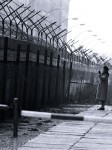
In the early hours of August 13th 1961, the government of East Germany ordered the closure of all borders between East and West Berlin. As the sun rose, Berliners were awoken by the sound of trucks, jackhammers and other heavy machinery. Watched by Soviet troops and East German police, workmen began breaking up roads, footpaths and other structures, before laying thousands of metres of temporary but impassable fencing, barricades and barbed wire. They worked for several days, completely surrounding the western zones of Berlin and cutting them off from the city’s eastern sectors. Within three days, almost 200 kilometres of fence line and barbed wire had been erected. The East German government’s official name for the new structure was Die anti-Faschistischer Schutzwall , or the ‘Anti-fascist Protective Wall’. It became known more simply as the Berlin Wall. According to East Germany, the Berlin Wall was erected to keep out Western spies and stop West German profiteers buying up state-subsidised East German goods. In reality, the wall was erected to stop the exodus of skilled labourers and technicians from East to West Berlin.
The erection of the Berlin Wall made headlines around the world. For the Western powers, it was not entirely unexpected. The United States and West Germany immediately went on high alert, in case the events in Berlin were a prelude to a Soviet-backed invasion of the city’s western zones. Six days later, US president John F. Kennedy ordered American reinforcements into West Berlin. More than 1,500 soldiers were transported into the city along East German autobahns (unlike in the Berlin Blockade , access to West Berlin through East German territory was not blocked). To prepare for another Soviet blockade, Kennedy also ordered a contingent of US cargo planes to be sent to West Germany. Some experts considered the Berlin Wall an act of aggression against Berliners in both zones and demanded strong action. Kennedy was more sanguine, suggesting that a wall “is a hell of a lot better than a war”.
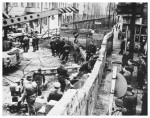
As weeks passed, the Berlin Wall became stronger and more sophisticated – and also more deadly. By June 1962, the East Germans had erected a second line of fencing, approximately 100 metres inside the first wall. The area between both fences was called ‘no man’s land’ or the ‘death strip’: under East German regulations, any unauthorised person observed there could be shot without warning. Houses within the ‘death strip’ were seized by the East German government, destroyed and levelled. The area was floodlit and covered with fine gravel that revealed footprints, which prevented people from sneaking across unnoticed. Structures that overhung the ‘death strip’, like balconies or trees, were booby-trapped with nails, spikes or barbed wire. In 1965, following several escape attempts where cars or trucks were used to punch through the fenceline, many sections of the barrier were replaced with pre-fabricated sections of concrete. This 3.4-metre high concrete barrier became the Berlin Wall’s most
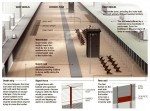
Needless to say, crossing the border between the two Berlins became even more restrictive. Prior to the late 1950s, it had been comparatively easy for West Berliners to visit relatives in eastern sectors, using a day pass issued by East German authorities. Travelling in the other direction was more difficult. East Berliners wanting to cross the city had to show a government permit, and these were difficult to obtain. Elderly East Berliners found these permits easier to obtain because their potential defection was not detrimental to East Germany’s economy. Those with business ties or immediate family in the West could be granted permits – though these permits were often denied or revoked without reason. Permit-holders could cross the Berlin Wall at several points, the best known of which was ‘Checkpoint Charlie’ in Friedrichstrasse.
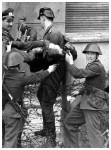
There were, of course, many attempts to cross the wall illegally. Some tried climbing, scampering or abseiling over the wall – however, the fortifications, barbed wire and armed Grepo (border police) made this a dangerous activity. Ramming through the wall or checkpoints in vehicles was a common tactic in the early years of the wall. This tactic was nullified when the East Germans rebuilt all roads approaching the wall as narrow zig-zags, preventing vehicles from accelerating. Others tried tunnelling under the wall or flying over it, using makeshift hot-air balloons, with varying levels of success. Around 230 people died attempting to cross the Berlin Wall. In 1962 Peter Fechter, an 18-year-old East German factory worker, was shot in the hip by a border patrol. Fechter bled to death in the ‘death strip’ while helpless onlookers on both sides watched impotently. Siegfried Noffke, who had been separated from his wife and daughter by the wall, dug a tunnel underneath it, only to be captured and machine-gunned by Stasi agents.

The Berlin Wall became a stark and foreboding symbol of the Cold War. In the West, its presence was exploited as propaganda: the Berlin Wall was evidence that East Germany was a failing state, that thousands of its people did not want to live under communism. US secretary of state Dean Rusk called the Wall “a monument to communist failure” while West German mayor Willy Brandt called it “the wall of shame”. In Washington, there was considerable debate about how the US should respond to the erection of the Berlin Wall. Ever the realist, President Kennedy knew that threats or shows of aggression might provoke confrontation or war. He instead focused his attention on West Berlin, hailing it as a small but determined bastion of freedom, locked inside an imprisoned state. Kennedy visited West Berlin in June 1963 and was greeted by ecstatic crowds, which cheered wildly and showered his motorcade with flowers and confetti. In the Rudolph Wilde Platz (later renamed the John F. Kennedy Platz), the US president told a rapt audience:
“There are many people in the world who really don’t understand, or say they don’t, what is the great issue between the free world and the Communist world. Let them come to Berlin. There are some who say that communism is the wave of the future. Let them come to Berlin. And there are some who say in Europe and elsewhere we can work with the Communists. Let them come to Berlin. And there are even a few who say that it is true that communism is an evil system, but it permits us to make economic progress. ‘Lass sie nach Berlin kommen’: let them come to Berlin… Freedom is indivisible, and when one man is enslaved, all men are not free… All free men, wherever they may live, are citizens of Berlin, and therefore, as a free man, I take pride in the words: ‘Ich bin ein Berliner’ (I am a citizen of Berlin).”
The Berlin Wall stood in place for almost 30 years. It remained the most tangible evidence of the Cold War and Iron Curtain separating the Soviet bloc from the West. Western leaders often referred to it as a symbol of Soviet repression. US president Ronald Reagan visited West Berlin in June 1987 and urged his Soviet counterpart, Mikhail Gorbachev , to “ tear down this wall “. It was the people of Berlin themselves who tore it down , during a public demonstration in November 1989.

1. The Berlin Wall was erected by the East German government in 1961. It was constructed to halt the exodus of people, particularly skilled workers, from communist East Berlin.
2. Construction of the Berlin Wall began before dawn on August 13th 1961. Borders were initially closed with fences and barbed wire, then later fortified with large concrete walls
3. The West condemned the Berlin Wall and exploited it as anti-communist propaganda. The wall was evidence, they said, that Soviet communism was failing and East Germany was now a prison state.
4. Over time, the Berlin Wall was heavily fortified, booby-trapped and policed by armed guards. Despite this, many Berliners tried to cross it, and around 230 were killed in the process.
5. The Berlin Wall would stand for almost three decades as a tangible sign of the Iron Curtain and the divisions between the Soviet bloc and the democratic West. The political changes of the late 1980s, the weakening of the East German government and a popular uprising led to the Berlin Wall being torn down in November 1989.

Walter Ulbricht and Nikita Khrushchev discuss closing the Berlin border (August 1961) The Allies protest the closure of borders in Berlin and the Soviets respond (August 1961) Walter Ulbricht to Nikita Khrushchev on outcomes of erecting the Berlin Wall (September 1961) John F. Kennedy’s “Ich bin ein Berliner” speech (June 1963) The United States and the Soviet Union exchange diplomatic cables on the Berlin Wall (August 1963) Ronald Reagan: “Mr Gorbachev, tear down this wall!” (June 1987) A radio address by Ronald Reagan on the Berlin Wall (August 1987)
Content on this page is © Alpha History 2018. This content may not be republished or distributed without permission. For more information please refer to our Terms of Use . This page was written by Jennifer Llewellyn, Jim Southey and Steve Thompson. To reference this page, use the following citation: J. Llewellyn et al, “The Berlin Wall”, Alpha History, accessed [today’s date], https://alphahistory.com/coldwar/berlin-wall/.
- Consumer Many large companies fail to provide sufficient information about their products and services. We bridge this gap by conducting in-depth research to address your unanswered questions
- Collectibles
The Berlin Wall: A Historian‘s Perspective on Its Purpose and Impact
- by history tools
- May 26, 2024
Introduction
The Berlin Wall, a symbol of the Cold War and the division of Germany, stood as a stark reminder of the ideological differences that shaped the latter half of the 20th century. Constructed overnight on August 13, 1961, the wall‘s primary purpose was to stem the tide of East Germans fleeing to the West in search of a better life. In this blog post, we‘ll delve into the historical context and reasons behind the construction of the Berlin Wall, as well as its impact on the city and its people, from a historian‘s perspective.
Historical Context: The Division of Germany and Berlin
The division of Germany and Berlin can be traced back to the aftermath of World War II. At the Yalta Conference in February 1945, the Allied powers (the United States, the United Kingdom, and the Soviet Union) agreed to divide Germany into occupation zones following its surrender. The subsequent Potsdam Conference in July-August 1945 further solidified these plans, with Berlin, located within the Soviet zone, also divided into four sectors.
As tensions between the Western Allies and the Soviet Union escalated, the differences in their political and economic ideologies became increasingly apparent. In 1948, the Soviet Union imposed a blockade on West Berlin, cutting off all land and water routes to the city. The Western Allies responded with the Berlin Airlift, supplying the city with food and supplies by air for nearly a year until the blockade was lifted in May 1949.
The division of Germany was formalized in 1949 with the establishment of the Federal Republic of Germany (West Germany) in the Western-controlled zones and the German Democratic Republic (East Germany) in the Soviet zone. The formation of NATO in 1949 and the Warsaw Pact in 1955 further entrenched the Cold War divide between the capitalist West and the communist East.
Life in East and West Germany: A Stark Contrast
The differences in living conditions and political systems between East and West Germany were stark. West Germany experienced rapid economic growth, known as the "Wirtschaftswunder" (economic miracle), thanks to the Marshall Plan and its adoption of a social market economy. Citizens enjoyed a higher standard of living, political freedom, and access to consumer goods.
In contrast, East Germany struggled with a centrally planned economy, resulting in lower productivity, shortages of goods, and a lower quality of life for its citizens. The GDR government maintained strict control over society, employing a vast network of informants (the Stasi) to monitor and suppress political dissent. East Germans faced travel restrictions, limited access to information, and political repression.
These disparities led to a growing number of East Germans fleeing to the West. Between 1949 and 1961, an estimated 3.5 million people, or roughly 20% of the East German population, had left the GDR, with many of them being young, educated, and skilled workers [1]. This brain drain had a significant impact on the East German economy, costing an estimated 22.5 billion Deutsche Marks (equivalent to $6.3 billion in 1961) [2].
The Berlin Crisis and the Construction of the Wall
The ongoing exodus of East Germans through Berlin, which remained the easiest crossing point between East and West, led to a series of events known as the Berlin Crisis of 1961. On June 4, 1961, Soviet leader Nikita Khrushchev issued an ultimatum to the Western powers, demanding the withdrawal of all armed forces from Berlin within six months and the establishment of a "free city" of West Berlin. Failure to comply, he warned, would result in the Soviet Union signing a separate peace treaty with East Germany and handing over control of access routes to Berlin to the GDR.
U.S. President John F. Kennedy, who had taken office just months earlier, met with Khrushchev in Vienna on June 3-4, 1961. During these tense discussions, Kennedy made it clear that the U.S. would defend West Berlin and its access routes, but he also expressed a willingness to compromise on issues such as the recognition of East Germany and the presence of Western troops in West Berlin. Khrushchev, interpreting Kennedy‘s stance as a sign of weakness, increased pressure on the city in the following weeks [3].
Meanwhile, the East German government, led by Walter Ulbricht, had been planning to seal off the border between East and West Berlin. On August 12, 1961, Ulbricht signed an order to close the border and begin constructing the wall. That night, in an operation codenamed "Rose," East German soldiers and police began erecting barbed wire fences and barriers along the border. Within days, construction of a more permanent concrete wall began, complete with guard towers, landmines, and orders to shoot anyone attempting to escape [4].
The international community reacted with shock and condemnation to the wall‘s construction. U.S. Vice President Lyndon B. Johnson visited West Berlin on August 19, 1961, and declared, "We have a solemn obligation to defend this city. The commitment of the United States to the freedom of West Berlin is unshakable" [5]. Despite these strong words, the Western powers ultimately accepted the wall‘s presence, focusing instead on maintaining their access rights to West Berlin.
The Impact and Legacy of the Berlin Wall
The Berlin Wall had a profound impact on the city and its residents. Families and friends were separated, and East Berliners were cut off from the economic opportunities and freedoms of the West. The wall also became a flashpoint for Cold War tensions, with U.S. and Soviet tanks famously facing off at Checkpoint Charlie in October 1961.
Despite the wall‘s formidable presence, many East Germans still attempted to escape. Between 1961 and 1989, an estimated 5,000 people successfully defected, while at least 140 people lost their lives trying to cross the border [6]. The most famous casualty was 18-year-old Peter Fechter, who was shot and left to bleed to death in the "death strip" on August 17, 1962, in full view of Western media and onlookers.
The Berlin Wall remained a symbol of oppression and division until November 9, 1989, when, amid growing protests and a rapidly changing political landscape in Eastern Europe, the East German government announced that citizens could freely travel to the West. Thousands of jubilant East and West Berliners gathered at the wall, chipping away at the concrete with hammers and chisels in a powerful display of unity and the triumph of freedom over tyranny.
The fall of the Berlin Wall paved the way for German reunification, which was formally achieved on October 3, 1990. The reunified Germany has since become a leader in the European Union and a symbol of the continent‘s post-Cold War integration and prosperity.
The Berlin Wall, built to prevent the mass emigration of East Germans to the West and to protect the GDR‘s faltering economy, stood as a powerful symbol of the Cold War divide for nearly three decades. Its construction had a profound impact on the lives of Berliners and served as a stark reminder of the ideological differences that shaped the post-World War II era.
From a historian‘s perspective, the Berlin Wall represents not only the physical division of a city and a nation but also the human cost of political ideology and the struggle for freedom and self-determination. Its legacy serves as a reminder of the importance of unity, cooperation, and the ongoing fight against oppression and division in all its forms.
As we reflect on the history of the Berlin Wall and its impact on the world, we must strive to learn from the past and work towards a future where the ideals of freedom, democracy, and human rights are upheld and protected for all.
Related posts:
- The Tragic Downfall of Democracy: President Paul von Hindenburg and Hitler‘s Rise to Power
- The Extraordinary Net Worth of Stephanie St. Clair, Harlem‘s Queen of Numbers
- The Remarkable Life of Sir Arthur Conan Doyle: Doctor, Adventurer, Spiritualist, and Legendary Creator of Sherlock Holmes
- Spitfire N3200: The Remarkable Journey of a Legendary Warbird
- Sir Adrian Carton de Wiart: A Soldier‘s Soldier and Hero of Two World Wars
- The Dark Underworld of Brezhnev‘s Kremlin During the Cold War
- The Devil‘s Chariots: How the First Tanks Terrorized German Troops in 1916
- The Last Days of the Romanovs: A Tragic End to Russia‘s Imperial Dynasty

The Berlin Wall as a political symbol
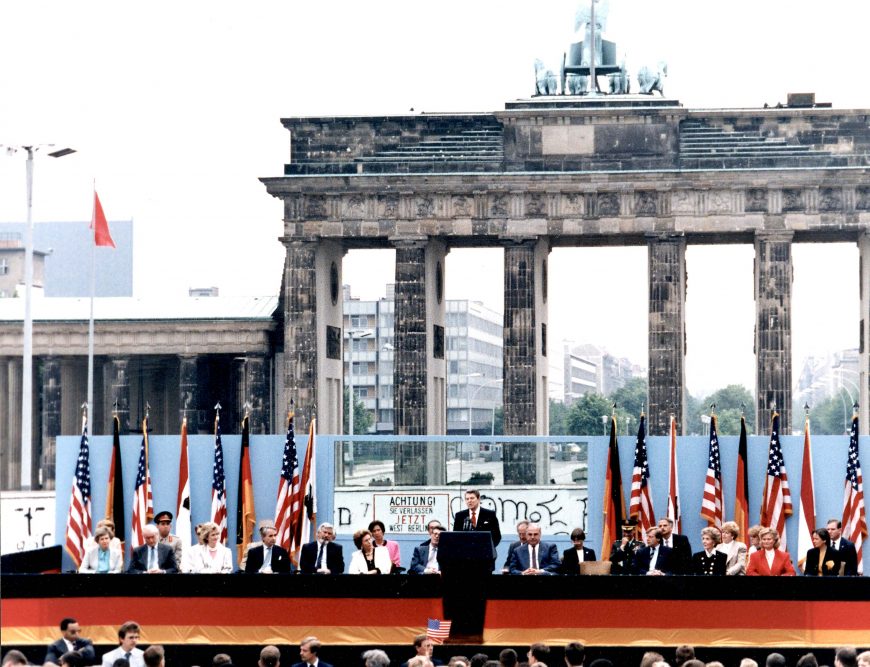
President Reagan giving a speech at the Berlin Wall, June 12, 1987 (photo: Reagan White House Photographs , CC0)
“Mr. Gorbachev, tear down this wall!” U.S. President Ronald Reagan
When Ronald Reagan addressed these words to Soviet leader Mikhail Gorbachev in June of 1987, few believed that just two years later the Berlin Wall would actually be dismantled. It seemed like a permanent fixture, symbolizing the irreparable divide between the Cold War powers. But by 1990, all but a few traces of the wall were gone.
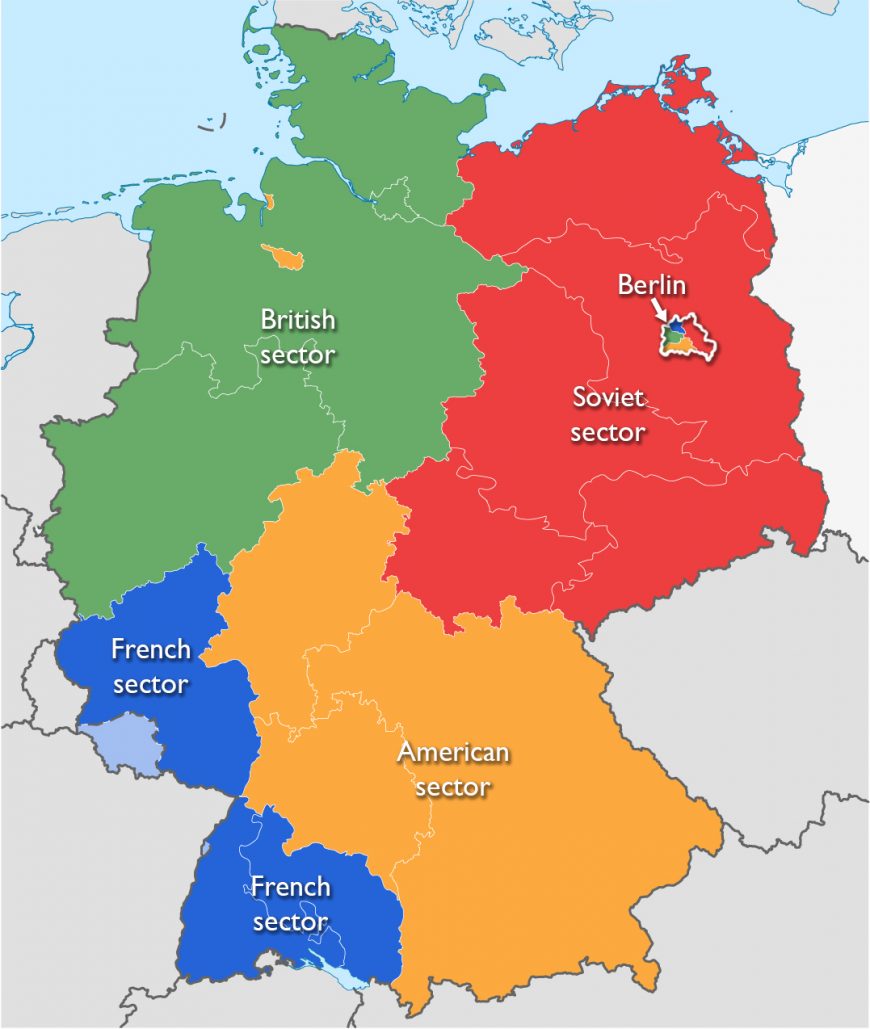
Map of post-WWII Germany divided between the Allied Powers (adapted by Dr. Naraelle Hohensee from WikiNight2 , GNU Free Documentation License)
Dividing a nation and a city
After Germany’s defeat in World War II, the Allied Powers each took control of a section of the country. By 1949, two Germanys emerged from this occupation. The Federal Republic of Germany (commonly known as West Germany) was an independent, democratic nation formed out of the British, French, and American zones. The German Democratic Republic (or GDR, commonly known as East Germany), was a socialist state under the leadership of the Soviet Union.
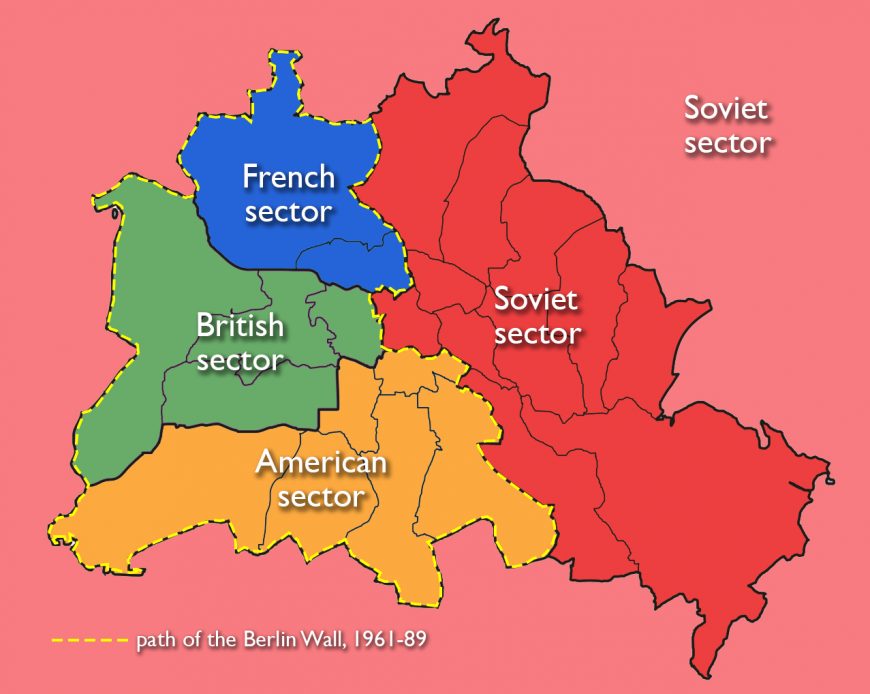
Map of the four post-WWII sectors of Berlin and the future path of the Berlin Wall (map adapted by Dr. Naraelle Hohensee from Paasikivi , CC BY-SA 4.0)
Berlin lay deep within what became East Germany, but as the former capital of Hitler’s empire, it received special treatment. The city itself was divided between the four Allied powers after the war, and so it, too, was divided into two parts once East and West Germany were created. East Berlin remained the capital of the GDR, while a new West German capital was established far to the west, in Bonn. West Berlin, formed from the British, French, and American sectors of the city, effectively became a tiny West German outpost in the midst of East Germany.
It may be surprising to learn that during the first decade after the country’s division, the border between East and West Berlin remained completely open. Aside from using different currencies, East and West Berlin were relatively indistinguishable—city trams still ran between the two halves, and people could visit friends and relatives on the other side of the city.
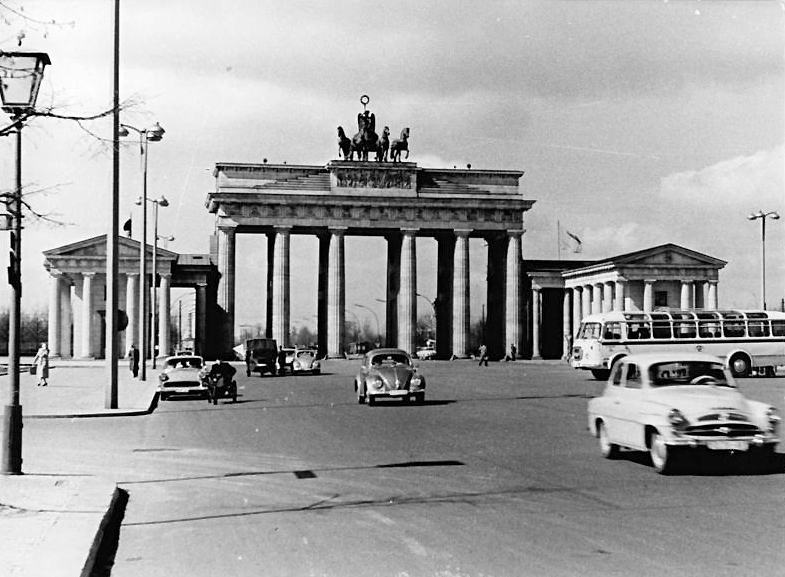
Traffic between West and East Berlin passes through the Brandenburg Gate, 1959 (photo: German Federal Archives , CC BY-SA 3.0)
Outside of Berlin, though, the differences between the two countries were becoming increasingly stark. West Germany experienced an “economic miracle” or “ Wirtschaftswunder ” thanks to subsidies from the Western powers, while East Germany struggled economically. Over the course of the 1950s, several million people chose to leave for West Germany to seek jobs and a better quality of life. In response, the East German government—afraid of losing its labor force, but also ashamed of the increasing tide of emigration—imposed continuously stricter limits on travel.
As leaving East Germany became increasingly difficult, West Berlin, with its open internal border to East Berlin, remained one of the only exit routes for those who wished to emigrate. It also operated as a “show-window for the West” (that is, a beacon of Western consumerism and liberal democracy placed prominently alongside the capital of communist East Germany). Most importantly, Berlin was a major site of political confrontation between the United States and Soviet Union, whose leaders were threatening one another with nuclear war. The city became a heated microcosm of Cold War politics.
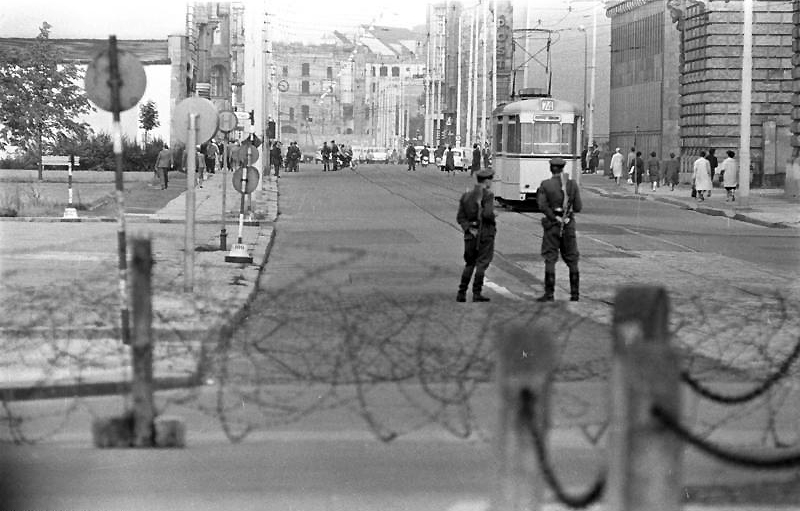
The border that would become the Berlin Wall, constructed with barbed wire, in August, 1961 (photo: Helmut J. Wolf , CC BY-SA 3.0)
Constructed overnight
On the morning of August 13, 1961, Berliners awoke to find that overnight, soldiers had used barbed wire to completely close the border between the two halves of the city—catching almost everyone by surprise. No warning had been given: trams stopped in their tracks, people headed to shop or visit friends on the other side of the city were turned back, and deadly force was employed to keep people from crossing. Over the next 25 years, the GDR fortified this border by erecting a series of solid walls and barbed-wire barriers, as well as a “death strip” of cleared land with tripwires and mines, all to prevent people from escaping. Over the next four decades, more than 140 people were killed in connection with the Berlin Wall.
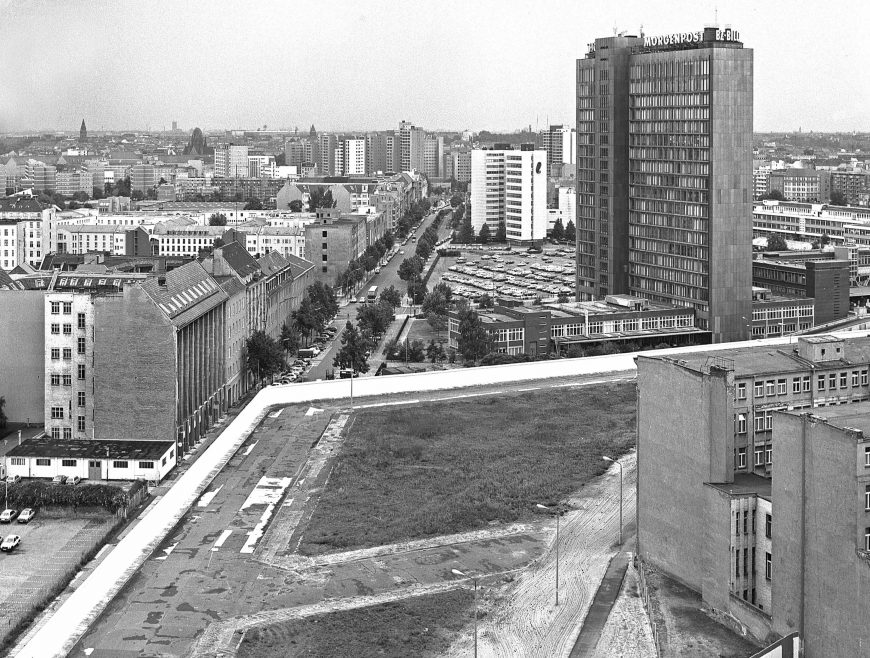
Looking into West Berlin over the Berlin Wall, 1987 (photo: Gerd Danigel, CC BY-SA 3.0)
The Berlin Wall not only prevented people from moving across the city—it also fundamentally changed how the two halves of the city functioned. Systems like water, electricity, sewer, and public transportation had to be separated. [1] Because the Berlin Wall went through the center of the city, urban development on each side began to focus elsewhere. What had been the city’s glittering, historic baroque city center was now located on the western outskirts of East Berlin, along the wall. It became virtually a forgotten wasteland, as new centers sprang up to the east and west.
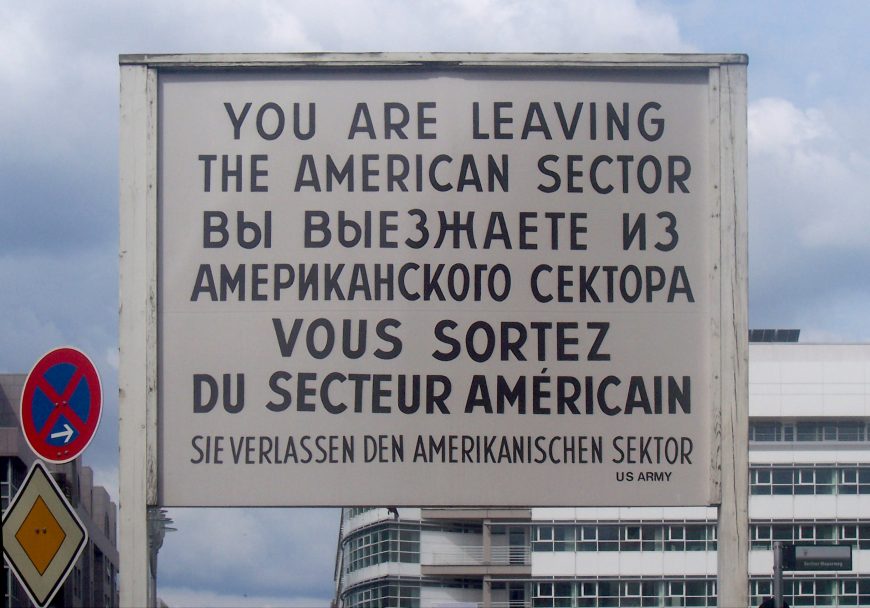
The sign at Checkpoint Charlie announcing the border between the American and Soviet sectors (East and West Berlin), now preserved as a memorial (photo: Henry Robbert , CC0)
A political symbol
Over time, particular points along the Berlin Wall became well-known symbols of the division. Checkpoint Charlie, a border crossing between the former American and Soviet regions of the city, was famous for its sign that boldly stated, “You are leaving the American sector.” The section of wall in front of the Brandenburg Gate, Berlin’s monumental baroque triumphal arch, was also often photographed. Potsdamer Platz, which had been a busy commercial center during the Weimar years but was left barren and desolate after heavy bombing in World War II, was one of the largest open areas next to the Berlin Wall. The viewing platform that was installed there on the western side became a popular destination for tourists.
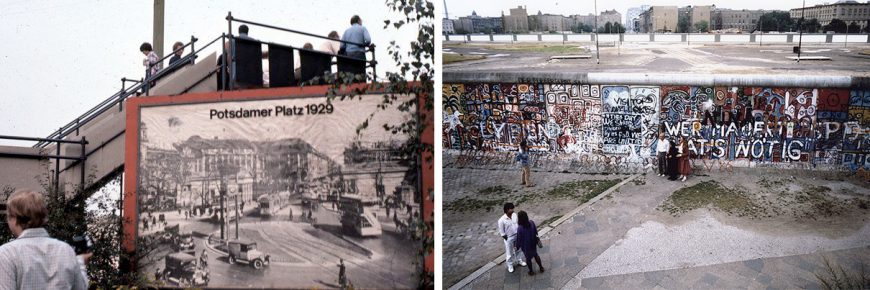
Left: the viewing platform on the West Berlin side of Potsdamer Platz, 1977, with a billboard displaying a photo of the site in 1929 (photo: BeenAroundAWhile , CC BY-SA 3.0); right: the view over the Berlin Wall, with West Berlin tourists in the foreground, 1986 (photo: Nancy Wong , CC BY-SA 3.0)
These often-photographed sites functioned as both objects of curiosity for Westerners, and symbols of the cruelty and repression imposed by the GDR and the Soviet Union. Their nearness to democratic West Berlin brought the Cold War conflict home: as opposed to wars happening “elsewhere” (such as the proxy wars that the United States and USSR were fighting in Vietnam and Afghanistan), this one was taking place on the doorstep of Western Europe.
The Berlin Wall also became a potent symbol through the art that appeared on its western side. As a political outpost, West Berlin became a place that many social radicals and artists called home. In the late 1970s and 1980s, the East German government replaced the hodge-podge of barriers that had been constructed over the years with a single, more defensible, 12-foot-high wall. The western side of this new enclosure provided the perfect surface for graffiti, and street artists from around the world flocked to Berlin to make their mark on it.
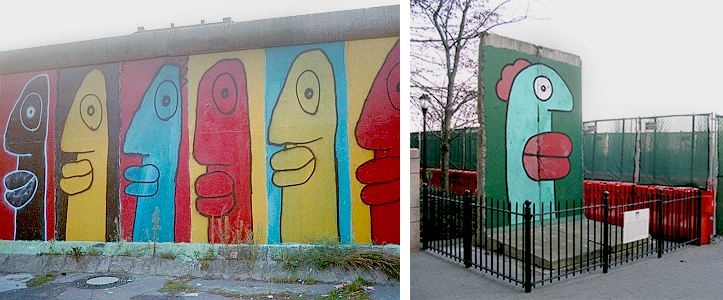
Thierry Noir murals, left: Berlin Wall, 1985 (photo: Thierry Noir , CC BY-SA 3.0); right: section of the Berlin Wall displayed in New York City (photo: Ronny-Bonny , CC BY 3.0)
Thierry Noir is one of the best-known artists to have painted the Berlin Wall in the 1980s. Today he continues to produce murals in his signature style, often featuring cartoonish, elongated heads with enlarged lips, on the remaining pieces of the Wall and elsewhere. Well-known international artists like Keith Haring also created murals on the Berlin Wall during this time.
Graffiti on the Berlin Wall was only visible to those on the West Berlin side. In East Germany, it was officially called an “ Antifaschistischer Schutzwall, ” or “anti-fascist protection barrier.” Despite the fact that those who tried to cross this border were killed or imprisoned and tortured, GDR propaganda claimed that the Berlin Wall was not a way to keep East Germans in, but a way to keep the forces of fascism out. Because even approaching the wall was dangerous, most East Berliners chose to ignore its existence in their daily lives.
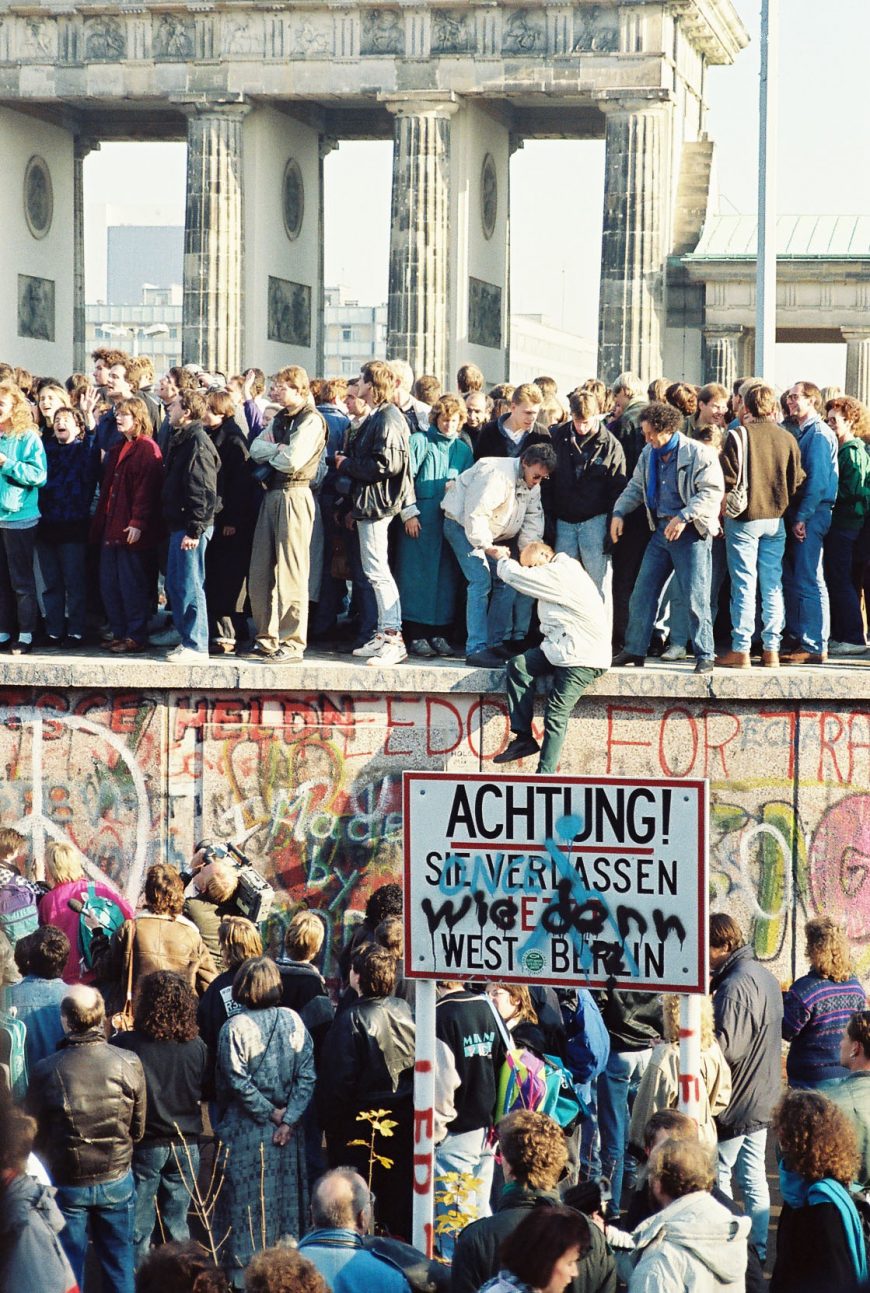
People atop the Berlin Wall near the Brandenburg Gate on 9 November 1989. The text on the sign “ Achtung! Sie verlassen jetzt West-Berlin ” (“Attention! You are now leaving West Berlin”) has been modified with the additional handwritten “ Wie denn? ” (“How?”) (photo: Sue Ream , CC BY 3.0)
The fall of the wall
Throughout the 1980s, the Soviet Union gradually loosened many of its policies as well as its control over the countries behind the Iron Curtain . By 1989, Hungary (also a Soviet satellite state, like East Germany) had opened its border, allowing a path for thousands of East Germans to leave for the West. Protests against the Communist government began to take place throughout East Germany. Finally, on November 9th, officials rather abruptly announced that the border between East and West was open—effective immediately.
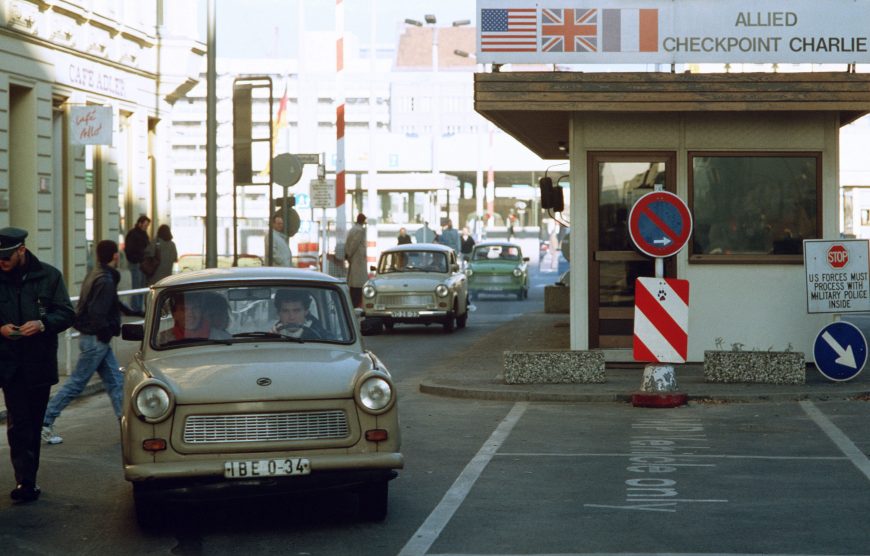
East Germans drive through Checkpoint Charlie after the fall of the Berlin Wall, 1989 (photo: Staff Sergeant F. Lee Cockran , CC0)
The news was broadcast across Germany and the world, and with a combination of euphoria and bewilderment, East Berliners streamed through the checkpoints, greeted by jubilant West Berliners. Soon, people began hacking away at the wall, and its “fall” became yet another Cold War symbol: this time of the fall of the Iron Curtain.
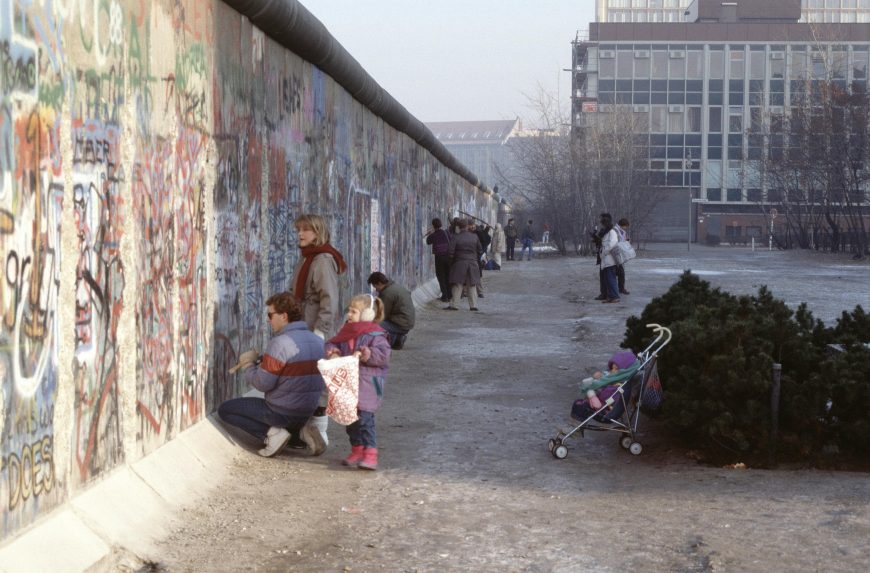
“ Mauerspechte ” chip off pieces of the Berlin Wall, December 1989 (photo: Aad van der Drift , CC BY 2.0)
Within a year, most of the Berlin Wall had been dismantled and sold—either unofficially, by “ Mauerspechte ” (“wall-peckers”), who chipped off pieces as souvenirs, or by the bulldozers and cranes of the East German government. The two halves of the nation and its capital city were legally reunified the following year, on October 3, 1990. [2]
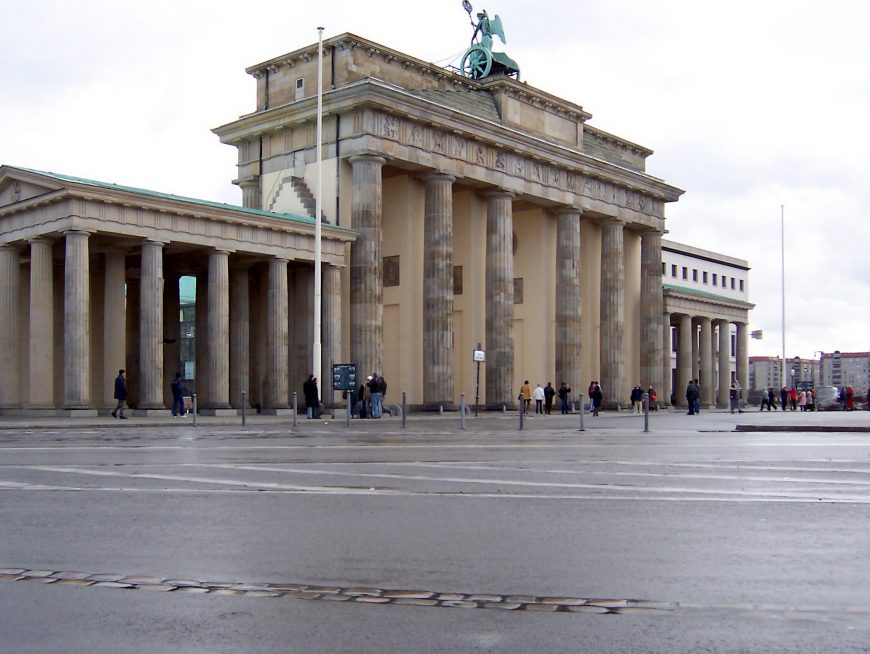
A double row of cobblestones now marks the former route of the Berlin Wall in front of the Brandenburg Gate (photo: Wici , CC0)
Where is the Berlin Wall?
Thirty years after its fall, the Berlin Wall is still the landmark most visitors look for when they come to Berlin. Most of the barrier has been erased from the urban landscape, but a few remaining sites pay tribute to its existence. The city of Berlin installed a line of double cobblestones in the ground to mark the wall’s former route.
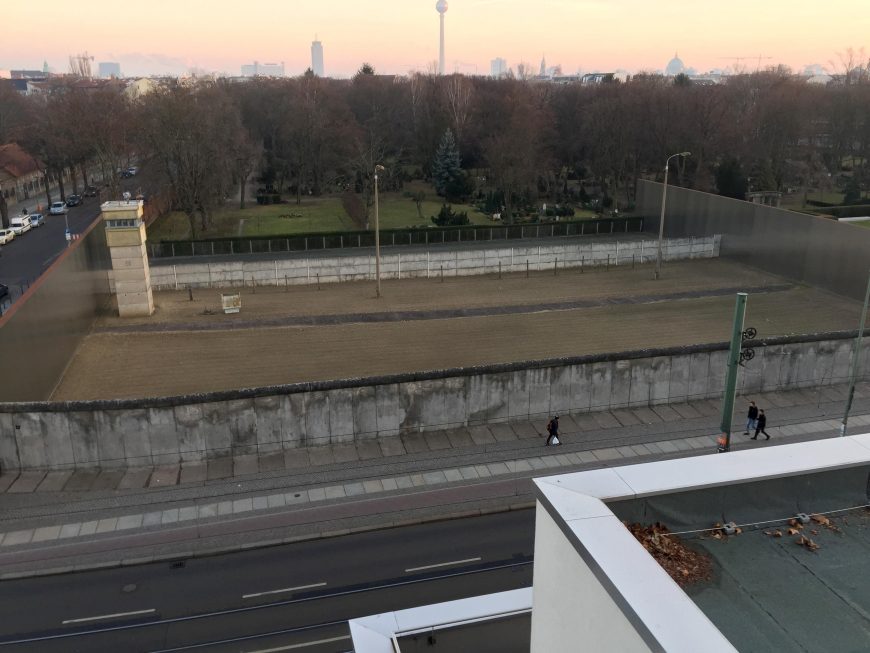
A preserved Berlin Wall border strip at the Berlin Wall Memorial on Bernauer Straße, Berlin, photographed from the viewing tower in the memorial documentation center (photo: Domaine public , CC0)
Informational boards and memorial markers have been installed throughout the city center to explain the history of the wall and honor those who died trying to cross it. Just north of the city center, one strip of the border system has been carefully preserved, including a guard tower and a “death strip,” accompanied by a small museum and information center.
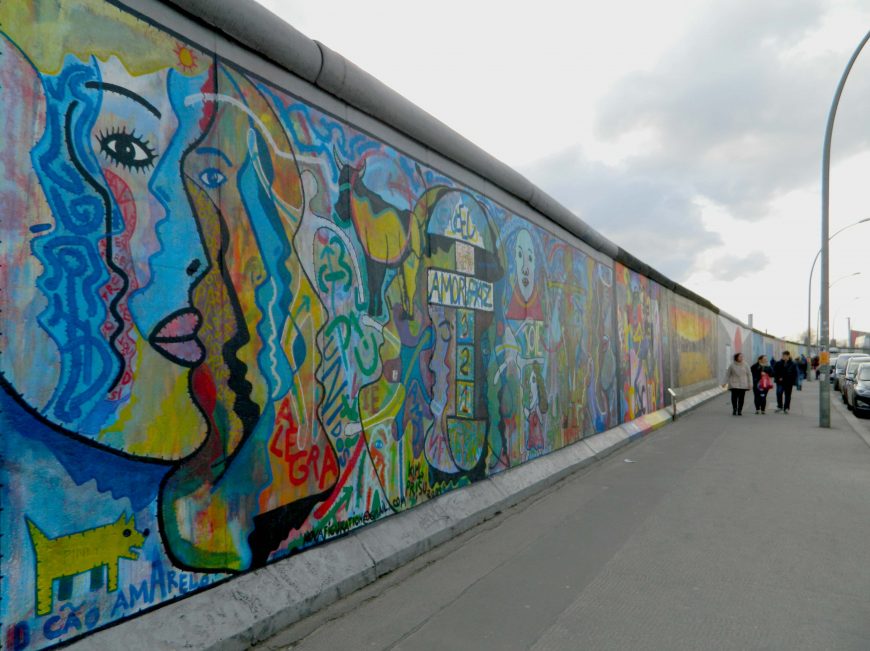
East Side Gallery, Berlin (photo: Freepenguin , CC BY-SA 3.0)
By far the most visible and most frequently visited piece of the wall in Berlin today is the East Side Gallery, a long strip of the wall covered in murals. Located at the end of the former East Berlin neighborhood of Friedrichshain, it stretches along the Spree River for over 1.3 km (0.8 miles). It was painted by a collaborative of international artists in 1990 on its eastern side (hence the name “East Side Gallery”) shortly after the opening of the border. (Painting on this side would not have been allowed when the GDR existed.) This section of the Berlin Wall was landmarked in 1991, though vandalism and development have had an impact. [3]
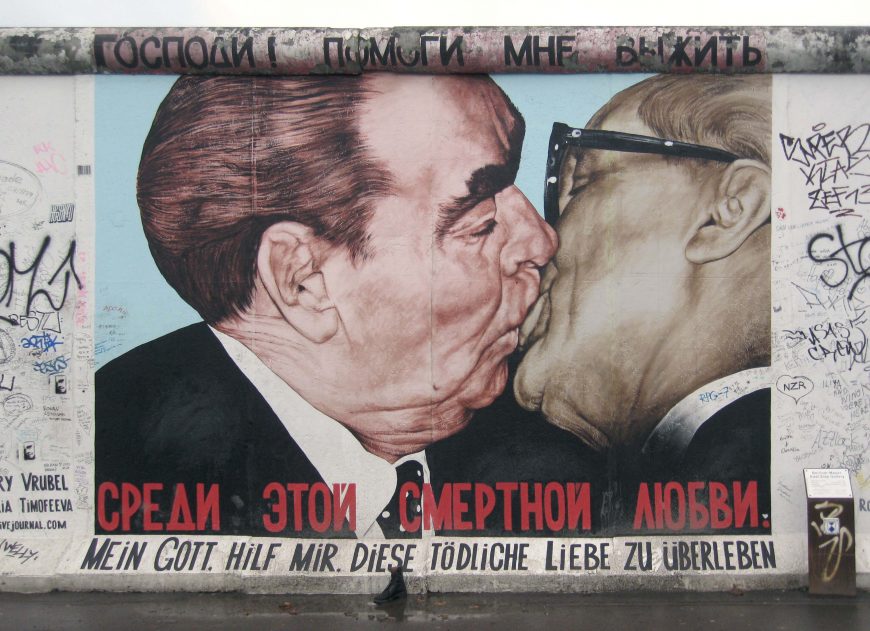
Dmitri Vrubel, Mein Gott, hilf mir, diese tödliche Liebe zu überleben (My God, Help Me to Survive This Deadly Love) , original created 1990, East Side Gallery, Berlin (photo: Pelorucho , CC BY-SA 3.0)
Several of the East Side murals (there are currently 101) have become especially famous. My God, Help Me to Survive This Deadly Love by Russian artist Dmitri Vrubel is based on a photograph of USSR and GDR leaders Leonid Brezhnev and Erich Honecker kissing each other on the lips. The mural at first shocks many viewers with its large-scale portrayal of two older men locked in a seemingly romantic embrace. This “fraternal kiss” had taken place in 1979, on the 30th anniversary of the GDR. The image alludes directly to the political intimacy between East Germany and the Soviet Union, while the title of the painting, appearing above and below the figures in Russian and German, adds a critical or satirical tone to the piece: who is hoping to “survive,” and why is this love “deadly”? One might surmise that the words are the voice of East Germany, for whom a relationship with the Soviet Union was ultimately both politically and economically destructive.
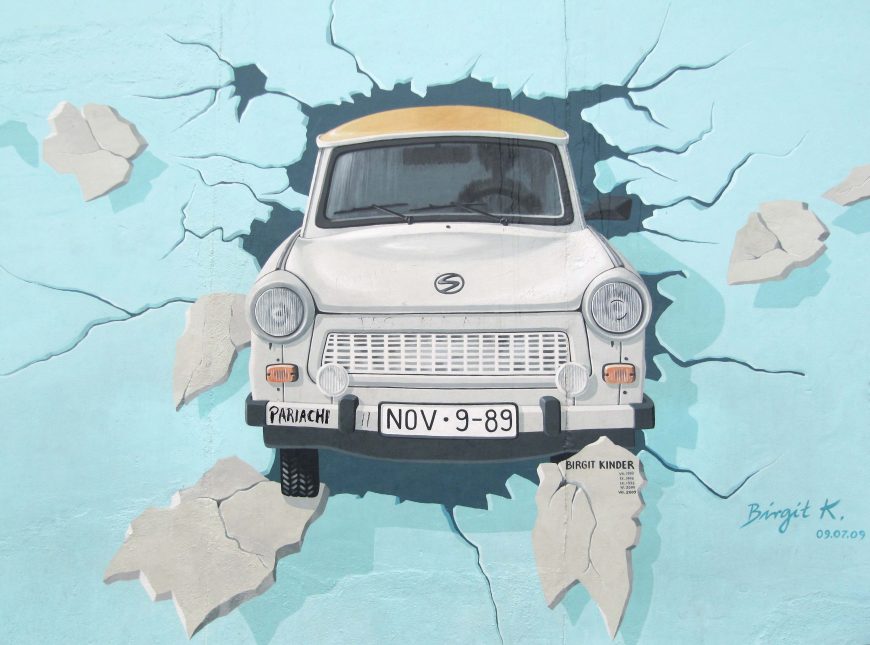
Birgit Kinder, Test the Best , 2009 version (detail), originally created 1990, East Side Gallery, Berlin (photo: Lorena a.k.a. Loretahur , CC BY-SA 2.0)
Another famous East Side Gallery mural is Birgit Kinder’s Test the Best , which depicts an East German Trabant (virtually the only brand of car available in the GDR) breaking through the Berlin Wall. Kinder painted a companion mural depicting the back of the car on another section of the Wall, which is now preserved in the State Ministry for the Environment.
Perhaps the most lasting, and problematic, legacy of the Berlin Wall is not physical at all, however. It is the so-called “Wall in the Head” that still separates former East Germans (“ Ossis ”) from West Germans (“ Wessis ”). The former East is still plagued by high unemployment and poverty today. Though Berlin has been put back together, the ongoing social and economic division between the two halves of the country has yet to be healed, and the Berlin Wall remains an important symbol for both the history and future of the nation, Europe, and the world.
[1] The two cities had been gradually separating their systems of governance as well as services (like police departments) and infrastructure (phone lines and transportation) since the end of the war, but the construction of the Wall in 1961 required that this process be swiftly and thoroughly completed.
[2] After East and West Germany reunited, it was still not clear whether the capital of the nation would be located in Bonn or Berlin. The parliament voted to locate the new capital in Berlin in 1991.
[3] The artists of the murals that make up the East Side Gallery have had to make numerous requests for additional funds from the city to clean and restore the murals because of frequent vandalism, and nearby development has resulted in the demolition of a few parts of the wall.
Bibliography
The Berlin Wall Memorial
Information on the Berlin Wall and its memorials from the city of Berlin
Keith Haring’s mural on the Berlin Wall
Thierry Noir’s account of painting the Berlin Wall
Photographs of the Berlin Wall in the 1980s by Edward Murray
Website of the East Side Gallery
Website of Birgit Kinder
An overview of Berlin history from Berlin.de
Emily Pugh, Architecture, Politics, and Identity in Divided Berlin (Pittsburgh: University of Pittsburgh Press, 2014).
Brian Ladd, The Ghosts of Berlin (Chicago: University of Chicago Press, 1998).
Janet Ward, Post-Wall Berlin: Borders, Space and Identity (London: Palgrave Macmillan, 2011).
Cite this page
Your donations help make art history free and accessible to everyone!
The Rise and Fall of the Berlin Wall
- People & Events
- Fads & Fashions
- Early 20th Century
- American History
- African American History
- African History
- Ancient History and Culture
- Asian History
- European History
- Latin American History
- Medieval & Renaissance History
- Military History
- Women's History
A Divided Germany and Berlin
Economic differences.
- Mass Emigration From the East
What to Do About West Berlin
The berlin wall goes up, berlin wall size and scope, berlin wall checkpoints, escape attempts and the death line.
- The Berlin Wall's 50th Victim
Communism Dismantled
The fall of the berlin wall.
- B.A., History, University of California at Davis
Erected in the dead of night on August 13, 1961, the Berlin Wall (known as Berliner Mauer in German) was a physical barrier between West Berlin and East Germany that kept disaffected East Germans from fleeing to the West.
When the Berlin Wall fell on November 9, 1989, its destruction was nearly as instantaneous as its creation. For 28 years, the Berlin Wall had been a symbol of the Cold War and the Iron Curtain between Soviet-led Communism and the democracies of the West. The Berlin Wall's fall was celebrated around the world.
At the end of World War II , the Allied powers divided conquered Germany into four zones. As agreed at the July 1945 Potsdam Conference , each was occupied by either the United States, Great Britain, France, or the Soviet Union . The same was done in Germany's capital city, Berlin.
The relationship between the Soviet Union and the other Allied powers quickly disintegrated. As a result, the cooperative atmosphere of the occupation of Germany turned competitive and aggressive. One of the best-known incidents was the Berlin Blockade in June 1948 during which the Soviet Union stopped all supplies from reaching West Berlin .
Although an eventual reunification of Germany had been intended, the new relationship between the Allied powers turned Germany into West versus East and democracy versus Communism .
In 1949, this new organization of Germany became official when the three zones occupied by the United States, Great Britain , and France combined to form West Germany (the Federal Republic of Germany, or FRG). The zone occupied by the Soviet Union quickly followed by forming East Germany (the German Democratic Republic, or GDR).
This same division into West and East occurred in Berlin . Since the city of Berlin had been situated entirely within the Soviet Zone of Occupation, West Berlin became an island of democracy within Communist East Germany .
Living conditions in West Germany and East Germany became distinctly different shortly after the war.
With the help and support of its occupying powers, West Germany set up a capitalist society . The economy experienced such rapid growth that it became known as the "economic miracle." With hard work, individuals living in West Germany lived well, bought gadgets and appliances, and traveled as they wished.
Nearly the opposite was true in East Germany. The Soviet Union had viewed their zone as a spoil of war. They pilfered factory equipment and other valuable assets from their zone and shipped them back to the Soviet Union.
When East Germany became its own country in 1949, it was under the direct influence of the Soviet Union, and a Communist society was established. The economy of East Germany dragged and individual freedoms were severely restricted.
Mass Emigration From the East
Outside of Berlin, East Germany had been fortified in 1952. By the late 1950s, many people living in East Germany wanted out. No longer able to stand the repressive living conditions, they decided to head to West Berlin. Although some would be stopped on their way, hundreds of thousands made it across the border.
Once across, these refugees were housed in warehouses and then flown to West Germany. Many of those who escaped were young, trained professionals. By the early 1960s, East Germany was rapidly losing its labor force and population .
Scholars estimate that between 1949 and 1961, nearly 3 million of the GDR's 18 million populace fled East Germany. The government was desperate to stop this mass exodus, and the obvious leak was the easy access East Germans had to West Berlin.
With support from the Soviet Union, several attempts were made to take over the city of West Berlin. Although the Soviet Union even threatened the United States with the use of nuclear weapons over this issue, the U.S. and other Western countries were committed to defending West Berlin.
Desperate to keep its citizens, East Germany knew something needed to be done. Famously, two months before the Berlin Wall appeared, Walter Ulbricht, Head of the State Council of the GDR (1960–1973) said, " Niemand hat die Absicht, eine Mauer zu errichten," which translates to, "No one intends to build a wall."
After this statement, the exodus of East Germans only increased. Over the next two months of 1961, nearly 20,000 people fled to the West.
Rumors spread that something might happen to tighten the border along East and West Berlin. No one was expecting the speed—nor the absoluteness—of the Berlin Wall.
Just after midnight on August 12–13, 1961, trucks with soldiers and construction workers rumbled through East Berlin. While most Berliners were sleeping, these crews began tearing up streets that entered West Berlin. They dug holes for concrete posts and strung barbed wire across the border. Telephone wires between East and West Berlin were also cut and railroad lines were blocked.
Berliners were shocked when they woke up that morning. What had once been a fluid border was now rigid. No longer could East Berliners cross the border for operas , plays, soccer games , or any other activity. Around 50,000 to 70,000 East Berlin commuters could no longer head to West Berlin for well-paying jobs. Families and friends could no longer cross the border to meet loved ones.
Whichever side of the border one went to sleep during the night of August 12, they were stuck on that side for decades.
The total length of the Berlin Wall was 96 miles (155 kilometers). It cut not only through the center of Berlin but also wrapped around West Berlin, entirely cutting it off from the rest of East Germany.
The wall itself went through four major transformations during its 28-year history. It started as a barbed-wire fence with concrete posts. On August 15 it was quickly replaced with a sturdier, more permanent structure made of concrete blocks and topped with barbed wire. The first two versions of the wall were replaced by a third version in 1965 consisting of concrete supported by steel girders.
The fourth version of the Berlin Wall, constructed from 1975 to 1980, was the most complicated and thorough. It consisted of concrete slabs reaching nearly 12 feet high (3.6 meters) and 4 feet wide (1.2 m). It also had a smooth pipe across the top to hinder anyone from scaling it.
When the Berlin Wall fell in 1989, a 300-foot No Man's Land was along the exterior with an additional inner wall. Soldiers patrolled with dogs and a raked ground revealed any footprints. The East Germans also installed anti-vehicle trenches, electric fences, massive light systems, 302 watchtowers, 20 bunkers, and even minefields.
Over the years, propaganda from the East German government would say that the people of East Germany welcomed the Wall. In reality, the oppression they suffered and the potential consequences they faced kept many from speaking out to the contrary.
Although most of the border between East and West consisted of layers of preventative measures, there were little more than a handful of official openings along the Berlin Wall. These checkpoints were for the infrequent use of officials and others with special permission to cross the border.
The most famous was Checkpoint Charlie , located between East and West Berlin at Friedrichstrasse. Checkpoint Charlie was the main access point for Allied personnel and Westerners to cross the border. Soon after the Berlin Wall was built, Checkpoint Charlie became an icon of the Cold War , frequently featured in movies and books.
The Berlin Wall prevented the majority of East Germans from emigrating to the West, but it did not deter everyone. During the history of the Berlin Wall, it is estimated that about 5,000 people made it safely across.
Some early attempts were simple, like throwing a rope over the Berlin Wall and climbing. Others were brash, like ramming a truck or bus into the Berlin Wall and making a run for it. Still, others were suicidal as some people jumped from the upper-story windows of apartment buildings that bordered the Berlin Wall.
In September 1961, the windows of these buildings were boarded up and the sewers connecting East and West were shut off. Other buildings were torn down to clear space for what would become known as the Todeslinie , the "Death Line" or "Death Strip." This open area allowed a direct line of fire so East German soldiers could carry out Shiessbefehl , a 1960 order that they were to shoot anyone trying to escape. At least 12 were killed within the first year.
As the Berlin Wall grew stronger and larger, escape attempts became more elaborately planned. Some people dug tunnels from the basements of buildings in East Berlin, under the Berlin Wall, and into West Berlin. Another group saved scraps of cloth and built a hot air balloon to fly over the Wall.
Unfortunately, not all escape attempts were successful. Since the East German guards were allowed to shoot anyone nearing the eastern side without warning, there was always a chance of death in any and all escape plots. At least 140 people died at the Berlin Wall.
The Berlin Wall's 50th Victim
One of the most infamous cases of a failed attempt occurred on August 17, 1962. In the early afternoon, two 18-year-old men ran toward the Wall to scale it. The first of the young men to reach it was successful. The second, Peter Fechter, was not.
As he was about to scale the Wall, a border guard opened fire. Fechter continued to climb but ran out of energy just as he reached the top. He then tumbled back onto the East German side. To the shock of the world, Fechter was left there. The East German guards did not shoot him again nor did they go to his aid.
Fechter shouted in agony for nearly an hour. Once he bled to death, East German guards carried off his body. He became a permanent symbol of the struggle for freedom.
The fall of the Berlin Wall happened nearly as suddenly as its rise. There had been signs that the Communist bloc was weakening, but the East German Communist leaders insisted that East Germany needed a moderate change rather than a drastic revolution. East German citizens did not agree.
Russian leader Mikhail Gorbachev (1985–1991) was attempting to save his country and decided to break off from many of its satellites. As Communism began to falter in Poland, Hungary, and Czechoslovakia in 1988 and 1989, new exodus points were opened to East Germans who wanted to flee to the West.
In East Germany, protests against the government were countered by threats of violence from its leader, Erich Honecker (1971–1989). In October 1989, Honecker was forced to resign after losing support from Gorbachev. He was replaced by Egon Krenz who decided that violence would not solve the country's problems. Krenz also loosened travel restrictions from East Germany.
Suddenly, on the evening of November 9, 1989, East German government official Günter Schabowski blundered by stating in an announcement, "Permanent relocations can be done through all border checkpoints between the GDR [East Germany] into the FRG [West Germany] or West Berlin."
People were in shock. Were the borders really open? East Germans tentatively approached the border and found border guards were letting people cross.
Very quickly, the Berlin Wall was inundated with people from both sides. Some began chipping at the Berlin Wall with hammers and chisels. There was an impromptu and massive celebration along the Berlin Wall, with people hugging, kissing, singing, cheering, and crying.
The Berlin Wall was eventually chipped away into smaller pieces (some the size of a coin and others in big slabs). The pieces have become collectibles and are stored in homes and museums. There is also now a Berlin Wall Memorial at the site on Bernauer Strasse.
After the Berlin Wall fell, East and West Germany reunified into a single German state on October 3, 1990.
Harrison, Hope M. Driving the Soviets up the Wall: Soviet-East German Relations, 1953-1961 . Princeton NJ: Princeton University Press, 2011.
Major, Patrick. “ Walled In: Ordinary East Germans' Responses to 13 August 1961 .” German Politics & Society, vol. 29, no. 2, 2011, pp. 8–22.
Friedman, Peter. " I was a Reverse Commuter Across the Berlin Wall ." The Wall Street Journal , 8 Nov. 2019.
" Berlin Wall: Facts & Figures ." National Cold War Exhibition , Royal Air Force Museum.
Rottman, Gordon L. The Berlin Wall and the Intra-German Border 1961–89 . Bloomsbury, 2012.
" The Wall ." Mauer Museum: Haus am Checkpoint Charlie.
Hertle, Hans-Hermann and Maria Nooke (eds.). The Victims at the Berlin Wall, 1961–1989. A Biographical Handbook . Berlin: Zentrum für Zeithistorische Forschung Potsdam and Stiftung Berliner Mauer, Aug. 2017.
- A History of Mengele's Gruesome Experiments on Twins
- The Downfall of Communism
- Cold War Glossary
- 32 Ronald Reagan Quotes You Should Know
- Biography of Spiro Agnew: The Vice President Who Resigned
- Stalin's Body Removed From Lenin's Tomb
- Biography of Albert Einstein, Theoretical Physicist
- Hitler's Political Statement Before His Suicide
- Pictures of Adolph Hitler
- Max Planck Formulates Quantum Theory
- The Day the Mona Lisa Was Stolen
- Biography of Harry S. Truman, 33rd President of the United States
- Alfred Hitchcock
- China's Boxer Rebellion of 1900
- 10 Facts About Adolf Hitler
- What Is Communism? Definition and Examples
Home — Essay Samples — Geography & Travel — Berlin — The history of Berlin wall
The History of Berlin Wall
- Categories: Berlin Germany
About this sample

Words: 1569 |
Published: Sep 20, 2018
Words: 1569 | Pages: 3 | 8 min read
Table of contents
Berlin wall essay outline, berlin wall essay example, introduction.
- The significance of the Berlin Wall in dividing East and West Berlin
- The political context of the Allies and Soviets in post-World War II Berlin
The Berlin Wall's Construction and Purpose
- Nikita Khrushchev and Walter Ulbricht's decision to build the Berlin Wall
- The role of the Berlin Wall in preventing East Berliners from fleeing to the West
- Efforts to retain essential workers in East Berlin
The Challenges of Crossing the Berlin Wall
- Description of the physical barriers, including the "Death Strip"
- The desperation of East Berliners and creative methods used to cross
- The impact on families and professional lives due to the wall
The Fall of the Berlin Wall
- Schabowski's announcement and its consequences
- The destruction of the wall by the people
- The broader implications of the Berlin Wall's fall, including the end of the Cold War and reunification of Germany
Consequences and Legacy
- The lasting impact of the Berlin Wall on the people of Berlin
- The role of the wall in shaping the city's landscape
- Reflections on the significance of both the rise and fall of the Berlin Wall

Cite this Essay
Let us write you an essay from scratch
- 450+ experts on 30 subjects ready to help
- Custom essay delivered in as few as 3 hours
Get high-quality help

Verified writer
- Expert in: Geography & Travel

+ 120 experts online
By clicking “Check Writers’ Offers”, you agree to our terms of service and privacy policy . We’ll occasionally send you promo and account related email
No need to pay just yet!
Related Essays
1 pages / 554 words
4 pages / 1760 words
5 pages / 2162 words
1 pages / 589 words
Remember! This is just a sample.
You can get your custom paper by one of our expert writers.
121 writers online
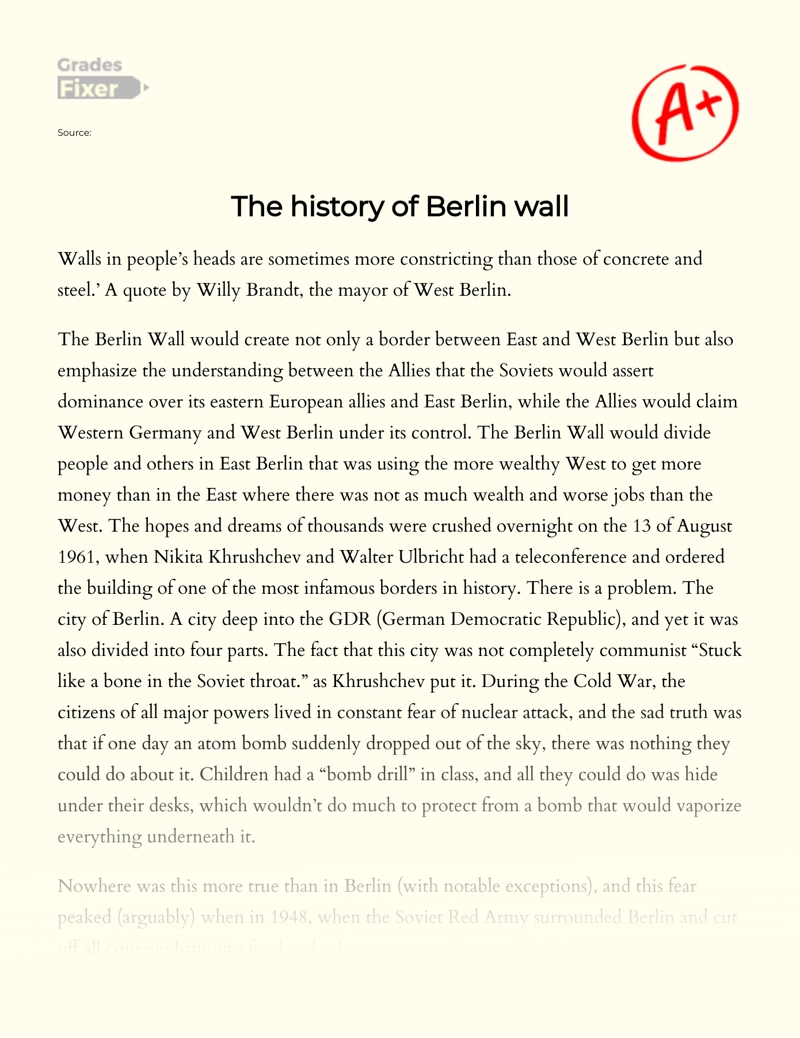
Still can’t find what you need?
Browse our vast selection of original essay samples, each expertly formatted and styled
Related Essays on Berlin
"The Berlin Boxing Club," a historical novel written by Robert Sharenow, offers a compelling narrative set against the backdrop of Nazi Germany. The novel follows the coming-of-age story of Karl Stern, a Jewish teenager who [...]
The fall of the Berlin Wall on November 9, 1989, was a pivotal moment in modern history, symbolizing the end of the Cold War and the beginning of a new era of political transformation in Europe. The Berlin Wall, erected in 1961 [...]
German properties continue to grow during Brexit. Even the rentals are constantly growing in the city and property is rather unaffordable for the local buyers. Germany offered easy citizenships to Britons during Brexit, [...]
In June of 1987, the world looked to President Ronald Reagan as he traveled to Berlin to address the impact of one of the world’s greatest symbols of communism: The Berlin Wall. For nearly twenty years, the “Iron Curtain” stood [...]
THE PARIS PEACE ACCORDS: Compromises to end the Vietnam WarHarini Venkatachalapathi World History Honors Period 2 Mr.Coburn 11 / 18 / 18 "Was it the poor decisions made by civilian leaders, a hostile media, and the antiwar [...]
This essay endeavors to understand the negative impacts Glastonbury Festival has on a multitude of areas within British society focusing on four main areas, economic; environment; politics and society. Through critical [...]
Related Topics
By clicking “Send”, you agree to our Terms of service and Privacy statement . We will occasionally send you account related emails.
Where do you want us to send this sample?
By clicking “Continue”, you agree to our terms of service and privacy policy.
Be careful. This essay is not unique
This essay was donated by a student and is likely to have been used and submitted before
Download this Sample
Free samples may contain mistakes and not unique parts
Sorry, we could not paraphrase this essay. Our professional writers can rewrite it and get you a unique paper.
Please check your inbox.
We can write you a custom essay that will follow your exact instructions and meet the deadlines. Let's fix your grades together!
Get Your Personalized Essay in 3 Hours or Less!
We use cookies to personalyze your web-site experience. By continuing we’ll assume you board with our cookie policy .
- Instructions Followed To The Letter
- Deadlines Met At Every Stage
- Unique And Plagiarism Free
The New York Times
The learning network | text to text | the fall of the berlin wall: reporting in 1989 and remembering 25 years later.


Text to Text | The Fall of the Berlin Wall: Reporting in 1989 and Remembering 25 Years Later
Berlin’s wall of light.
To commemorate the 25th anniversary of the fall of the Berlin Wall, the artists Christopher and Marc Bauder created a border of lights called the “Lichtgrenze.”

Text to Text
Teaching ideas based on New York Times content.
- See all Text to Text »
- See all lesson plans »
Twenty-five years ago this week, East Germans danced atop the concrete wall that had sealed off their communist-ruled world from the West.
In this Text to Text , we compare that moment of initial euphoria in 1989 — the first night of freedom in Berlin, followed by the end of the Soviet Union and the collapse of communism across Eastern Europe — with today’s Berlin, a transformed city in which many do not remember the oppressive divisions of the past. In follow-up activities, students can evaluate the choices made since 1989 and decide if the Cold War is really over.
As with all of our Text to Text lessons, we link below to many more resources you might choose to pair instead of the ones we’ve chosen. Even more reporting and multimedia can be found on the Berlin Wall Times Topics page .
Background:
Below is a quiz we wrote in 2009 for the 20th anniversary of the fall of the Berlin Wall. Students might take it after they read the background information to test what they know, or to find more links to archival Times reporting.
From 1961 to 1989, the Berlin Wall divided the historic capital of Germany into two separate worlds: the communist-controlled East Berlin, and the enclave of a democratic West Berlin surrounded on all sides by East Germany. What was it like to live behind the Berlin Wall? Classes may wish to begin by reviewing this brief history of the city following World War II, including its division by the Allies and the dramatic events surrounding the Berlin Airlift of 1948, when its food supplies were cut off by the Soviet Union in the early years of the Cold War. Then read this overview and watch this video from German broadcaster Deutsche Welle showing where the wall was located, when it was built and how it was defended. More than 600 people were killed trying to escape East Germany between 1961 and 1988.
Such pressures came boiling to the surface on the night of Nov. 9, 1989. Ferdinand Protzman, a New York Times reporter, was attending what seemed to be a run-of-the-mill news conference when an East German government spokesman bungled an announcement and a border guard’s warnings were ignored. Within hours, thousands of people were streaming across the border in a tide that the guards were unwilling to block .

As a Times reporter, Serge Schmemann, wrote in 2009 , recalling his reporting that day 20 years earlier, “There was nothing through most of that gray, chilly Thursday to suggest that it would come to symbolize one of the great transitions of the 20th century, the triumphant end of a failed system.”
Twenty-five years later, Berlin is no longer divided. The city is now the capital of a unified Germany. Yet, because of migration and the passage of time, perhaps as many as half of Berliners never had a direct experience with the wall. In this Text to Text, we compare on-the-ground Times reporting from Berlin in 1989 and 2014, and consider why history should remain alive for not only those who were directly affected, but especially for those who never experienced it firsthand.
Key Question: Why should we remember and commemorate pivotal moments in history? What relevance do they have for us in today’s world?
Activity Sheets: As students read and discuss, they might take notes using one or more of the three graphic organizers (PDFs) we have created for our Text to Text feature:
- Comparing Two or More Texts
- Double-Entry Chart for Close Reading
- Document Analysis Questions
Text 1: Excerpt from “Clamor in the East: East Berliners Explore Land Long Forbidden,” by Ferdinand Protzman, The New York Times, Nov. 10, 1989

“I can’t believe I’m here,” an elderly East Berliner told reporters as he crossed into the West. “This is what we have dreamed of all these years.” “It’s over, it’s all over, I can’t believe it,” said an East German as he ducked to get under the red-and-white barriers at the Bornholmer Strasse crossing, an act that might have cost him his life several months ago. “First of all, I must take a step on your soil,” another East Berliner who crossed at Bornholmer Strasse about midnight told a West German television reporter. “I can’t describe it,” a young woman said with tears in her eyes. “I would never have believed it possible.” A middle-aged East Berliner summed up his feelings with the words: “Joy, entirely great joy.’ ” “I don’t know what we’re going to do, just drive around and see what’s going on,” said a 34-year-old East Berliner as he sat at the wheel of his orange Trabant auto on the glittering Kurfurstendamm, West Berlin’s main shopping street. “We’re here for the first time. I’ll go home in a few hours. My wife and kids are waiting for me. But I wasn’t going to miss this.” … By 3 a.m. today, West Berlin was beginning to resemble a gigantic block party. East Germans were crossing at Checkpoint Charlie at the rate of about 450 an hour. They were greeted at the border by about 500 West Berliners chanting, “We want in! We want in!” and “Open up! Open up!” The street was littered with beer and wine bottles. A lesser, but steady, stream of weary, tipsy East Berliners was heading home. The low clouds, which had sprinkled drizzle on the city for most of the day had cleared, leaving a brilliant three-quarter moon and a sky full of stars. Onlookers stood on the border barriers on the Western side of Checkpoint Charlie, drinking and cheering as groups of waving, smiling East Berliners arrived. Facing them was a line of nervous-looking East German border guards.
Text 2: Excerpt from “Lights and Celebration Where a Wall Divided Berlin,” by Melissa Eddy, The New York Times, Nov. 8, 2014

Frank Ebert, a human-rights activist from East Berlin, was so sure the breach in the Berlin Wall was temporary that he spent part of his first day in the West stocking up on ink, paper, books and other materials that would be impossible to get once he returned to the Communist side. Within two or three days, though, reality hit. “You couldn’t close the wall again,” recalled Mr. Ebert, who helped to organize celebrations here this weekend for the anniversary of the wall’s demise. “Very quickly it was normal.” Twenty-five years later, it is so normal that many residents of this increasingly cosmopolitan European capital can hardly relate to life in the heavily militarized, divided city of the days before Nov. 9, 1989. Moritz van Dülmen, director of Kulturprojekte Berlin, the organizer of the anniversary event, estimates that roughly half of today’s residents never had direct experiences with the 96-mile barrier. Now, slick, modern buildings trace the wall’s footprint. A section of what was known as “death strip” — a sliver of heavily mined land lined by watch towers — is now a park known for its Sunday flea market and open-air karaoke. While dozens of institutes, museums and governmental offices are dedicated to remembering Germany’s complicated and painful history, their focus is largely on the crimes and victims of Hitler’s Third Reich. What has surprised Mr. Ebert and others is the speed with which the Berlin Wall’s history, albeit relatively brief, has been forgotten, and how quickly people have left it in the past.
For Writing or Discussion:
- In the first article, what was the range of responses to the opening of the border dividing Berlin?
- Why do you think Berliners showed so little fear of the border guards after years of harsh treatment? And why did the guards appear to show little fear of the enormous crowds?
- Do the politicians or officials quoted in 1989 seem to have any better idea than normal citizens of what’s going on or what will come next? Do they show any wisdom or leadership in the heat of the moment?
- How had Berlin changed in the 25 years since the wall came down, according to the second article?
- After reading the articles, watch the video above. Do you think Berlin’s “Wall of Light” installation is an effective way to commemorate the Berlin Wall and its fall? Why?
- Why is it important for Berliners — even those who are new to the city — to remember how their city was once divided by a heavily militarized border?
- What historical events during your lifetime should be remembered and commemorated so that they are never forgotten? How should they be memorialized?
Going Further
Think Back: Obama's Cold War
In addressing crises in Ukraine, Syria and elsewhere, President Obama seems to be drawing on the memory of old-time superpower struggles, says Sam Tanenhaus.
Editing Churchill
In 1946, the former Prime Minister of Britain, Winston Churchill, gave a landmark speech at a college in Fulton, Mo., in which he warned of an “Iron Curtain” of Soviet domination that had descended across Europe, and urged the United States to respond. Was his warning effective, or should he have made different points in order to minimize the potential for conflict and perhaps avoid the Cold War? Read and score Churchill’s 1946 speech, giving him a point for each useful recommendation or prediction, and deducting a point for each inaccuracy or missed opportunity. Then read this analysis of the Cold War by Sam Tanenhaus, a Times reporter, “A History Lesson that Needs Relearning .” Use his story as a blueprint for writing a revision of Churchill’s speech, incorporating the real-life lessons of the Cold War. As a culminating activity, students can hold a public speaking contest, delivering their “Churchill 2014” speeches before a live audience.
Who Won the Cold War?
In the years after the Berlin Wall fell, some gave strong credit to President Ronald Reagan or his predecessor, George H.W. Bush, for winning the Cold War . But George F. Kennan, a historian and diplomat who helped craft America’s strategy for containing the spread of communism following World War II, called those claims “silly.” Read the different versions, and do further research on the question. Then design a poster explaining how the Cold War turned out and who was responsible.
Is America Keeping the Peace or Losing It?
Last week, speaking on the anniversary of the Berlin Wall’s opening, Mikhail Gorbachev, the last leader of the Soviet Union who presided over the country at the fall of the Berlin wall, said the West was on the brink of a “new Cold War” , and he laid the blame squarely at the feet of America and NATO. He is not the first to make such a claim. Thomas Friedman, the Times columnist, and others have been making similar arguments, saying the United States pushed Russia into a corner by expanding NATO right to its borders in the 1990s. Organize a class debate, with different groups each researching a different time period in the recent history of NATO and developing both “pro” and “con” perspectives on the question of whether it was right for the alliance to keep growing.
Struggles and Success in Eastern Europe
The years after communism were marked by optimism but also harsh economic struggle across Eastern Europe. Some countries, like Poland , have prospered. But others like Bulgaria and Hungary have faced challenges adopting flourishing, democratic systems, with some aged or rural citizens saying they had it better under communism . Pick a country that abandoned communism in the late 1980s or early ‘90s, and research what’s happened there since that time, including with its economic situation . Then make a presentation on the ways in which life has or hasn’t improved in that country since 1989.
Good Memories and Hard Ones

How should the heroes and victims of the Cold War be remembered, even as pieces of the Berlin Wall are sold and moved around the world? Now a New York Times bureau chief, Alison Smale arrived just in time for the end of communism in East Berlin in 1989 and, as a reporter for the Associated Press, found herself at the center of a thrilling story when she accompanied one woman across the wall on Nov. 9. This year she captured the other side of the story, interviewing families whose relatives were killed trying to cross before 1989. Consider the ways people might memorialize both the happy and somber sides of the story. Then hold a class contest to design your own real or virtual memorial to the Cold War.
A New Cold War?
A quarter-century after the fall of the Berlin Wall, the Soviet Union is relegated to history, and people can move freely across borders in the formerly communist countries of Eastern Europe. But over the past year, pressure has increased between Russia and its neighbors, many of whom joined the NATO military alliance formed by the United States and its allies following the collapse of the Soviet Union. Along with the headline news of Russia’s incursions in eastern Ukraine , other flash points have emerged — including in Estonia, the Baltic Sea and even cyberspace. Read “In Air and Cyberspace, on Land and Sea, Russia Shows Muscle” to get an overview of some of the latest confrontations, or focus on the disputed Russian stealth mission in Estonia to get a sense of the high tension along the border. Are we in the middle of a new Cold War, or perhaps a continuation of the old one? Do additional research on whether experts think current tensions rise to the level of a “Cold War,” and then hold a class debate on the subject.
Other Resources
- Lesson | From Concrete to Memory: Scrapbooking the Berlin Wall
- Lesson | Kiev in Chaos: Teaching About the Crisis in Ukraine
- Lesson | Behind the Olympics: Teaching About Russia in the Putin Era
- Lesson | Flash Points: Searching for Modern Lessons in the Cuban Missile Crisis
- Times Topic Page | The Berlin Wall
- Berlin Wall Interactive | A Division Through Time
- Berlin Wall Slide Show | Twenty Years Later
- Woodrow Wilson International Center for Scholars | Cold War International History Project
- Roy Rosenzweig Center for History and New Media | Making the History of 1989
This resource may be used to address the academic standards listed below.
Common Core E.L.A. Anchor Standards
1 Read closely to determine what the text says explicitly and to make logical inferences from it; cite specific textual evidence when writing or speaking to support conclusions drawn from the text.
7 Integrate and evaluate content presented in diverse media and formats, including visually and quantitatively, as well as in words.
Common Core Standards for Mathematical Practice
World history.
43 Understands how post-World War II reconstruction occurred, new international power relations took shape, and colonial empires broke up.
44 Understands the search for community, stability, and peace in an interdependent world.
45 Understands major global trends since World War II World History Across the Eras.
46 Understands long-term changes and recurring patterns in world history.
Comments are no longer being accepted.
Never forget about this! Best! E.S.
What's Next
Ch. 29 The Cold War
The building of the berlin wall, 32.5.4: the building of the berlin wall.
The Berlin Wall was a barrier that divided Germany from 1961 to 1989, aimed at preventing East Germans from fleeing to stop economically disastrous migration of workers.
Learning Objective
Deconstruct Soviet Union’s reasons for building the Berlin Wall
- Berlin was divided between East and West since the end of World War II, with the Western powers occupying the Western portion and the Soviet Union occupying the East.
- After increasing tensions between the Soviets and the Western powers during the first 15 years of the Cold War, the Soviet Union decided to build a physical barrier between East and West Berlin, thereby creating a real counterpoint to the symbolic “Iron Curtain” that had divided East and West since 1945.
- The main purpose of the Wall was to prevent East Germans from fleeing, thus stopping an economically disastrous migration of workers.
- The Berlin Wall was officially referred to as the “Anti-Fascist Protective Wall” by East German authorities, implying that the NATO countries and West Germany in particular were considered “fascists” by East German propaganda.
- With the closing of the East-West sector boundary in Berlin, the vast majority of East Germans could no longer travel or emigrate to West Germany, and Berlin soon went from the easiest place to make an unauthorized crossing between East and West Germany to the most difficult.
- Many families were split, while East Berliners employed in the West were cut off from their jobs.
The Berlin Wall was a barrier that divided Germany from 1961 to 1989. Constructed by the German Democratic Republic (GDR, East Germany) starting on August 13, 1961, the Wall completely cut off West Berlin from surrounding East Germany and from East Berlin until government officials opened it in November 1989. Its demolition officially began on June 13, 1990 and was completed in 1992. The barrier included guard towers placed along large concrete walls, which circumscribed a wide area (later known as the “death strip”) that contained anti-vehicle trenches, “fakir beds,” and other defenses. The Eastern Bloc claimed that the Wall was erected to protect its population from fascist elements conspiring to prevent the “will of the people” in building a socialist state in East Germany. In practice, the Wall prevented the massive emigration and defection that had marked East Germany and the communist Eastern Bloc during the post-World War II period.
The Berlin Wall was officially referred to as the “Anti-Fascist Protective Wall” by GDR authorities, implying that the NATO countries and West Germany in particular were considered “fascists” by GDR propaganda. The West Berlin city government sometimes referred to it as the “Wall of Shame”—a term coined by mayor Willy Brandt—while condemning the Wall’s restriction on freedom of movement. Along with the separate and much longer Inner German border (IGB), which demarcated the border between East and West Germany, it came to symbolize a physical marker of the “Iron Curtain” that separated Western Europe and the Eastern Bloc during the Cold War.
Before the Wall’s erection, 3.5 million East Germans circumvented Eastern Bloc emigration restrictions and defected from the GDR, many by crossing over the border from East Berlin into West Berlin. From there, they could travel to West Germany and other Western European countries. Between 1961 and 1989, the Wall prevented almost all such emigration. During this period, around 5,000 people attempted to escape over the Wall, with an estimated death toll ranging from 136 to more than 200 in and around Berlin.

Berlin Wall: Photograph of the Berlin Wall taken from the West side. The Wall was built in 1961 to prevent East Germans from fleeing and stop an economically disastrous migration of workers. It was a symbol of the Cold War, and its fall in 1989 marked the approaching end of the war.
Effects of the Berlin Wall
With the closing of the East-West sector boundary in Berlin, the vast majority of East Germans could no longer travel or emigrate to West Germany. Berlin soon went from the easiest place to make an unauthorized crossing between East and West Germany to the most difficult. Many families were split, and East Berliners employed in the West were cut off from their jobs. West Berlin became an isolated exclave in a hostile land. West Berliners demonstrated against the Wall, led by their Mayor Willy Brandt, who strongly criticized the United States for failing to respond. Allied intelligence agencies had hypothesized about a wall to stop the flood of refugees, but the main candidate for its location was around the perimeter of the city. In 1961, Secretary of State Dean Rusk proclaimed, “The Wall certainly ought not to be a permanent feature of the European landscape. I see no reason why the Soviet Union should think it is … to their advantage in any way to leave there that monument to communist failure.”
United States and UK sources expected the Soviet sector to be sealed off from West Berlin, but were surprised how long they took to do so. They considered the Wall an end to concerns about a GDR/Soviet retaking or capture of the whole of Berlin; the Wall would presumably have been an unnecessary project if such plans were afloat. Thus, they concluded that the possibility of a Soviet military conflict over Berlin had decreased.
The East German government claimed that the Wall was an “anti-fascist protective rampart” intended to dissuade aggression from the West. Another official justification was the activities of Western agents in Eastern Europe. The Eastern German government also claimed that West Berliners were buying state-subsidized goods in East Berlin. East Germans and others greeted such statements with skepticism, as most of the time the border was closed for citizens of East Germany traveling to the West but not for residents of West Berlin travelling East. The construction of the Wall caused considerable hardship to families divided by it. Most people believed that the Wall was mainly a means of preventing the citizens of East Germany from entering or fleeing to West Berlin.
Defection Attempts
During the years of the Wall, around 5,000 people successfully defected to West Berlin. The number of people who died trying to cross the Wall or as a result of the Wall’s existence has been disputed. The most vocal claims by Alexandra Hildebrandt, Director of the Checkpoint Charlie Museum and widow of the Museum’s founder, estimated the death toll to be well above 200.
The East German government issued shooting orders to border guards dealing with defectors, though these are not the same as “shoot to kill” orders. GDR officials denied issuing the latter. In an October 1973 order later discovered by researchers, guards were instructed that people attempting to cross the Wall were criminals and needed to be shot: “Do not hesitate to use your firearm, not even when the border is breached in the company of women and children, which is a tactic the traitors have often used.”
Early successful escapes involved people jumping the initial barbed wire or leaping out of apartment windows along the line, but these ended as the Wall was fortified. East German authorities no longer permitted apartments near the Wall to be occupied, and any building near the Wall had its windows boarded and later bricked up. On August 15, 1961, Conrad Schumann was the first East German border guard to escape by jumping the barbed wire to West Berlin.
On 22 August 1961, Ida Siekmann was the first casualty at the Berlin Wall: she died after she jumped out of her third floor apartment at 48 Bernauer Strasse. The first person to be shot and killed while trying to cross to West Berlin was Günter Litfin, a 24-year-old tailor. He attempted to swim across the Spree Canal to West Germany on August 24, 1961, the same day that East German police received shoot-to-kill orders to prevent anyone from escaping.
East Germans successfully defected by a variety of methods: digging long tunnels under the Wall, waiting for favorable winds and taking a hot air balloon, sliding along aerial wires, flying ultralights and, in one instance, simply driving a sports car at full speed through the basic initial fortifications. When a metal beam was placed at checkpoints to prevent this kind of defection, up to four people (two in the front seats and possibly two in the boot) drove under the bar in a sports car that had been modified to allow the roof and windscreen to come away when it made contact with the beam. They lay flat and kept driving forward. The East Germans then built zig-zagging roads at checkpoints.
Attributions
- “Cold War.” https://en.wikipedia.org/wiki/Cold_War . Wikipedia CC BY-SA 3.0 .
- “Berlin Wall.” https://en.wikipedia.org/wiki/Berlin_Wall . Wikipedia CC BY-SA 3.0 .
- “Berlinermauer-2.jpg.” https://en.wikipedia.org/wiki/Cold_War#/media/File:Berlinermauer.jpg . Wikipedia CC BY-SA 3.0 .
- Boundless World History. Authored by : Boundless. Located at : https://courses.lumenlearning.com/boundless-worldhistory/ . License : CC BY-SA: Attribution-ShareAlike

Privacy Policy
Berlin Wall
Accessibility
How accessible is this website.
Accessibility statement
Who can you contact if you have questions, comments or feedback regarding digital accessibility?
Contact information for the relevant contact person
Where can I find additional information about accessibility in Berlin?
State Commissioner for Digital Accessibility
Primary navigation
The construction of the berlin wall.
Image: Landesarchiv Berlin 0076393/Horst Siegmann
Around 2.7 million people left the GDR and East Berlin between 1949 and 1961, causing increasing difficulties for the leadership of the East German communist party, the SED. Around half of this steady stream of refugees were young people under the age of 25. Roughly half a million people crossed the sector borders in Berlin each day in both directions, enabling them to compare living conditions on both sides. In 1960 alone, around 200,000 people made a permanent move to the West. The GDR was on the brink of social and economic collapse.
As late as 15 June 1961, GDR head of state Walter Ulbricht declared that no one had any intention of building a wall [Film 0.81 MB]. On 12 August 1961, the GDR Council of Ministers announced that “in order to put a stop to the hostile activity of West Germany’s and West Berlin’s revanchist and militaristic forces, border controls of the kind generally found in every sovereign state will be set up at the border of the German Democratic Republic, including the border to the western sectors of Greater Berlin.” What the Council did not say was that this measure was directed primarily against the GDR’s own population, which would no longer be permitted to cross the border.
In the early morning hours of 13 August 1961 [Film 5.80 MB], temporary barriers were put up at the border separating the Soviet sector from West Berlin, and the asphalt and cobblestones on the connecting roads were ripped up. Police and transport police units, along with members of “workers’ militias,” stood guard and turned away all traffic at the sector boundaries. The SED leadership’s choice of a Sunday during the summer holiday season for its operation was probably no coincidence.
Over the next few days and weeks, the coils of barbed wire strung along the border to West Berlin were replaced by a wall of concrete slabs and hollow blocks. This was built by East Berlin construction workers under the close scrutiny of GDR border guards.Houses on, for instance, Bernauer Strasse, where the sidewalks belonged to the Wedding borough (West Berlin) and the southern row of houses to Mitte (East Berlin), were quickly integrated into the border fortifications: the GDR government had the front entrances and ground floor windows bricked up. Residents could get to their apartments only via the courtyard, which was in East Berlin. Many people were evicted from their homes already in 1961 – not only in Bernauer Strasse, but also in other border areas.
From one day to the next, the Wall separated streets, squares, and neighborhoods from each other and severed public transportation links. On the evening of August 13, Governing Mayor Willy Brandt said in a speech to the House of Representatives: “The Berlin Senate publicly condemns the illegal and inhuman measures being taken by those who are dividing Germany, oppressing East Berlin, and threatening West Berlin….”
On 25 October 1961, American and Soviet tanks faced off against each other at the Friedrichstrasse border crossing used by foreign nationals (Checkpoint Charlie), because GDR border guards had attempted to check the identification of representatives of the Western Allies as they entered the Soviet sector. In the American view, the Allied right to move freely throughout all of Berlin had been violated. For sixteen hours, the two nuclear powers confronted each other from a distance of just a few meters, and the people of that era felt the imminent threat of war. The next day, both sides withdrew. Thanks to a diplomatic initiative by America’s President Kennedy, the head of the Soviet government and communist party, Nikita Khrushchev, had confirmed the four-power status of all of Berlin, at least for now.
In the years to come, the barriers were modified, reinforced, and further expanded, and the system of controls at the border was perfected. The Wall running through the city center, which separated East and West Berlin from one another, was 43.1 kilometers long. The border fortifications separating West Berlin from the rest of the GDR were 111.9 kilometers long. Well over 100,000 citizens of the GDR tried to escape across the inner-German border or the Berlin Wall between 1961 and 1988. More than 600 of them were shot and killed by GDR border guards or died in other ways during their escape attempt. At least 140 people died at the Berlin Wall alone between 1961 and 1989.
- Chronicle of the Berlin Wall
- Berlin Wall Memorial
Governing Mayor of Berlin – Senate Chancellery -
- Jüdenstr. 1 10178 Berlin
- Tel.: +49 30 9026-2435
- Fax: +49 30 9026-2285
- E-mail an die Landesredaktion Berlin.de in der Senatskanzlei
Further information about this

Will you join us in lighting the way for the leaders of tomorrow?
The cold war in berlin, two years after the construction of the berlin wall, president kennedy paid a historic visit to berlin to challenge soviet oppression and offer hope to the people of the divided city..
At the end of World War II, the main Allied powers—the United States, France, Great Britain, and the Soviet Union—divided Germany into two zones.
The Soviet Union occupied East Germany and installed a rigidly controlled communist state. The other three Allies shared the occupation of West Germany and helped rebuild the country as a capitalist democracy. The City of Berlin, located 200 miles inside East Germany, was also divided. Half of the city—West Berlin—was actually part of West Germany.
Many East Germans did not want to live in a communist country and crossed into West Berlin, where they could either settle or find transportation to West Germany and beyond. By 1961, four million East Germans had moved west. This exodus illustrated East Germans' dissatisfaction with their way of life, and posed an economic threat as well, since East Germany was losing its workers.
A Summit with the Soviets
In June 1961, President John F. Kennedy traveled to Vienna, Austria, for a summit with Soviet leader Nikita Khrushchev. Not only was the summit unsuccessful in its goal of building trust, but it also increased tensions between the two superpowers—particularly in discussions regarding the divided city of Berlin.
During the summit, Khrushchev threatened to cut off Allied access to West Berlin. Kennedy was startled by Khrushchev's combative style and tone and unsettled by the threat. In an address to the American people on July 25 , President Kennedy announced that the United States might need to defend its rights in Berlin militarily:
So long as the communists insist that they are preparing to end by themselves unilaterally our rights in West Berlin and our commitments to its people, we must be prepared to defend those rights and those commitments. We will at times be ready to talk, if talk will help. But we must also be ready to resist with force, if force is used upon us. Either alone would fail. Together, they can serve the cause of freedom and peace.
President Kennedy ordered substantial increases in American intercontinental ballistic missile forces, added five new army divisions, and increased the nation's air power and military reserves.
The Berlin Wall
In the early morning hours of August 13, 1961, the people of East Berlin were awakened by the rumbling of heavy machinery barreling down their streets toward the line that divided the eastern and western parts of the city.
Groggy citizens looked on as work details began digging holes and jackhammering sidewalks, clearing the way for the barbed wire that would eventually be strung across the dividing line. Armed troops manned the crossing points between the two sides and, by morning, a ring of Soviet troops surrounded the city. Overnight, the freedom to pass between the two sections of Berlin ended.
Running across cemeteries and along canals, zigzagging through the city streets, the Berlin Wall was a chilling symbol of the Iron Curtain that divided all of Europe between communism and democracy. Berlin was at the heart of the Cold War.
In 1962, the Soviets and East Germans added a second barrier, about 100 yards behind the original wall, creating a tightly policed no man's land between the walls. After the wall went up, more than 260 people died attempting to flee to the West.
Though Kennedy chose not to challenge directly the Soviet Union's building of the Berlin Wall, he reluctantly resumed testing nuclear weapons in early 1962, following the lead of the Soviet Union.
"Let Them Come to Berlin"
In the summer of 1963, President Kennedy visited Berlin and was greeted by ecstatic crowds who showered his entourage with flowers, rice, and torn paper. In the Rudolph Wilde Platz, Kennedy gave one of his most memorable speeches to a rapt audience.
There are many people in the world who really don't understand, or say they don't, what is the great issue between the free world and the Communist world. Let them come to Berlin. There are some who say that communism is the wave of the future. Let them come to Berlin. And there are some who say in Europe and elsewhere we can work with the Communists. Let them come to Berlin. And there are even a few who say that it is true that communism is an evil system, but it permits us to make economic progress. Lass'sie nach Berlin kommen. Let them come to Berlin.
No other American politician had met with such joy and enthusiasm on a visit to Germany. Shortly after President Kennedy's death in November of 1963, the square where he had made his famous speech was renamed the John F. Kennedy Platz.
- History Classics
- Your Profile
- Find History on Facebook (Opens in a new window)
- Find History on Twitter (Opens in a new window)
- Find History on YouTube (Opens in a new window)
- Find History on Instagram (Opens in a new window)
- Find History on TikTok (Opens in a new window)
- This Day In History
- History Podcasts
- History Vault
10 Things You May Not Know About the Berlin Wall
By: Christopher Klein
Updated: August 1, 2024 | Original: November 7, 2014

1. The fall of the Berlin Wall happened by mistake.
At a press conference on the evening of November 9, 1989, East German politburo member Günter Schabowski prematurely announced that restrictions on travel visas would be lifted. When asked when the new policy would begin, he said, “Immediately, without delay.” In actuality, the policy was to be announced the following day and would still have required East Germans to go through a lengthy visa application process. Schabowski’s confused answers and erroneous media reports that border crossings had opened spurred thousands of East Berliners to the Berlin Wall .
At the Bornholmer Street checkpoint, Harald Jäger, the chief officer on duty, faced a mob growing in size and frustration. Receiving insults, rather than instructions, from his superiors and nervously expecting results of his cancer diagnostic tests the next day, the overwhelmed Jäger opened the border crossing on his own, and the other gates soon followed.
2. The Berlin Wall was erected more than 15 years into the Cold War.
More than 2 million East Germans, most of them skilled laborers and professionals, fled to the West between 1949 and 1961. The Soviet Union had rejected East Germany’s original request to build the wall in 1953, but with defections through West Berlin reaching 1,000 people a day by the summer of 1961, Soviet leader Nikita Khrushchev finally relented. The residents of Berlin awoke on the morning of August 13, 1961, to find barbed wire fencing had been installed on the border between the city’s east and west sections. Days later, East Germany began to fortify the barrier with concrete.
3. The Berlin Wall was actually two walls.
The 27-mile portion of the barrier separating Berlin into east and west consisted of two concrete walls between which was a “death strip” up to 160 yards wide that contained hundreds of watchtowers, miles of anti-vehicle trenches, guard dog runs, floodlights and trip-wire machine guns.
4. More than 100 people died trying to cross the Berlin Wall.
The Centre for Research on Contemporary History Potsdam and the Berlin Wall Memorial Site and Documentation Center report that at least 138 people were shot dead, suffered fatal accidents or committed suicide after failed escape attempts across the Berlin Wall. Other researchers place the death toll even higher. The first victim was Ida Siekmann, who died on August 22, 1961, after attempting to leap to a West Berlin street below her fourth-floor East Berlin apartment window. The last fatality occurred in March 1989 when a young East German attempting to fly over the wall in a hot air balloon crashed into power lines.

5. More than 5,000 escaped by going over and under the Berlin Wall.

The first defector to escape across the Berlin Wall was 19-year-old East German border guard Corporal Conrad Schumann, who was immortalized on film as he leapt over a 3-foot-high roll of barbed wire just two days after East Germany sealed the border. As the Berlin Wall grew more elaborate, so did escape plans. Fugitives hid in secret compartments of cars driven by visiting West Berliners, dug secret tunnels and crawled through sewers. The three Bethke brothers pulled off the most spectacular escapes. Eldest brother Ingo escaped by floating on an inflatable mattress across the Elbe River in 1975, and eight years later brother Holger soared over the wall on a steel cable he fired with a bow and arrow to a rooftop in West Berlin. In 1989 the pair flew an ultra-light plane over the wall and back to pick up youngest brother Egbert.
6. John F. Kennedy expressed relief when the Berlin Wall was erected.
In June 1961, Khrushchev warned President John F. Kennedy that he would blockade West Berlin if Western forces were not removed, a belligerent act that could lead to war. When Kennedy heard news that the communists had walled off East Berlin instead of cutting off West Berlin, he confided to an aide, “It’s not a very nice solution, but a wall is a hell of a lot better than a war. This is the end of the Berlin crisis. The other side panicked—not we. We’re going to do nothing now because there is no alternative except war.”

All the Ways People Escaped Across the Berlin Wall
Desperation drove ingenuity among East Germans determined to reach West Berlin.
The Surprising Human Factors Behind the Fall of the Berlin Wall
First came the botched press conference. Then the actions of an angry, tired secret police officer who thought he had nothing to lose. Soviet reaction wasn't good.
How Long Was the Berlin Wall?
Few symbols better captured the Cold War divide between western Europe and the Soviet bloc than the Berlin Wall, a concrete and barbed wire barrier that divided Germany’s largest city for nearly 30 years. As World War II wound to a close, Germany and Berlin were divided into four zones, each administered by one of […]
7. Kennedy did not tell Berliners he was a 'jelly doughnut.'
On June 26, 1963, Kennedy famously told a crowd at the Berlin Wall, “Ich bin ein Berliner.” The president intended to express solidarity with the citizens of Berlin by saying he was one of them, but some critics claimed that by adding the indefinite article “ein,” he actually called himself a jelly doughnut, known in much of Germany as a “Berliner.”
Linguists say, however, that the president did not commit a grammatical faux pas because “ein” is required when the speaker is speaking figuratively, not literally, about being of a certain nationality, as was obviously the case with Kennedy. In addition, the jam-filled pastry known as a “Berliner” in the rest of Germany is called a “pfannkuchen” in Berlin, so there would have been no confusion among the listeners.
8. East Germany called the wall the 'Antifascist Bulwark.'
Rather than keeping its citizens in, the East German government claimed it erected the Berlin Wall to keep Western fascists, spies and ideas out. Two weeks after ordering the construction of the “Antifaschistischer Schutzwall,” East German leader Walter Ulbricht claimed, “We have sealed the cracks in the fabric of our house and closed the holes through which the worst enemies of the German people could creep.”
9. The Brandenburg Gate had once been part of an 18th-century wall.
Prussian King Frederick William II commissioned the iconic triumphal arch straddling East and West Berlin that served as the iconic backdrop for famous presidential speeches by Kennedy and Ronald Reagan . When completed in 1791, the Brandenburg Gate was incorporated into the city’s original Customs Wall, which ringed the city beginning in the 1730s.
10. A piece of the wall stands in the bathroom of a Las Vegas casino.
Official demolition of the Berlin Wall began in the summer of 1990. More than 40,000 wall sections were recycled into building materials used for German reconstruction projects, but a few hundred segments were auctioned off and are now scattered around the globe from the Vatican gardens to the men’s room of the Main Street Station Casino in Las Vegas, where urinals are mounted on a graffiti-covered wall segment protected behind glass.

HISTORY Vault: Declassified: Rise and Fall of the Wall
Mine formerly guarded vaults and archives around the world to reveal untold stories about the brutal life and catastrophic death of the Berlin Wall, a central symbol of the 20th century's longest and deadliest war.

Sign up for Inside History
Get HISTORY’s most fascinating stories delivered to your inbox three times a week.
By submitting your information, you agree to receive emails from HISTORY and A+E Networks. You can opt out at any time. You must be 16 years or older and a resident of the United States.
More details : Privacy Notice | Terms of Use | Contact Us

IMAGES
COMMENTS
The Berlin Wall came to symbolize the Cold War's division of East from West Germany and of eastern from western Europe. About 5,000 East Germans managed to cross the Berlin Wall (by various means) and reach West Berlin safely, while another 5,000 were captured by East German authorities in the attempt and 191 more were killed during the actual crossing of the wall.
On August 13, 1961, the Communist government of East Germany began to build a barbed wire and concrete "Antifascistischer Schutzwall," or "antifascist bulwark," between East and West Berlin.
The Berlin Wall (German: Berliner ... At strategic points, the Wall was constructed to a somewhat weaker standard, so that East German and Soviet armored vehicles could easily break through in the event of war. [83] Smooth piping lined the top of the Wall, intended to make it more difficult to scale.
It was on 9 November 1989, five days after half a million people gathered in East Berlin in a mass protest, that the Berlin Wall dividing communist East Germany from West Germany crumbled. East ...
This Wall, which was in place from 1961 to 1989, separated Berlin into two parts, one of which belonged to East Germany and the other of which belonged to West Germany. In addition to being a ...
The Berlin Wall, a symbol of Cold War division. In the early hours of August 13th 1961, the government of East Germany ordered the closure of all borders between East and West Berlin. As the sun rose, Berliners were awoken by the sound of trucks, jackhammers and other heavy machinery. Watched by Soviet troops and East German police, workmen ...
Introduction. The Berlin Wall, a symbol of the Cold War and the division of Germany, stood as a stark reminder of the ideological differences that shaped the latter half of the 20th century. Constructed overnight on August 13, 1961, the wall's primary purpose was to stem the tide of East Germans fleeing to the West in search of a better life.
The Berlin Wall as a political symbol. "Mr. Gorbachev, tear down this wall!". U.S. President Ronald Reagan. When Ronald Reagan addressed these words to Soviet leader Mikhail Gorbachev in June of 1987, few believed that just two years later the Berlin Wall would actually be dismantled. It seemed like a permanent fixture, symbolizing the ...
The Berlin Wall fell after 28 years of separating communist East Germany from West Berlin. Learn more about the story of this iconic Cold War symbol. ... Hungary, and Czechoslovakia in 1988 and 1989, new exodus points were opened to East Germans who wanted to flee to the West. In East Germany, protests against the government were countered by ...
the Berlin Wall which divided that German city for 28 years. The National Declassification Center of the National Archives and Records Administration and the Historical Collections Division of the Central Intelligence Agency have partnered to publish newly declassified documents that reveal intimate details of the five month Berlin Crisis of 1961.
Act 2On August 13, 1961, the Soviet Union built the Berlin Wall. The wall kept the people of East Berlin from moving to West Berlin. Even after the wall was built, many people tried to get over the wall and to West Berlin. There were thousands of people that got into the west, but the journey into West Berlin was much harder than before the ...
Twenty-five years ago this week, East Germans danced atop the concrete wall that had sealed off their communist-ruled world from the West. In this Text to Text, we compare that moment of initial euphoria in 1989 — the first night of freedom in Berlin, followed by the end of the Soviet Union and the collapse of communism across Eastern Europe — with today's Berlin, a transformed city in ...
The Berlin Wall was a barrier that divided Germany from 1961 to 1989, aimed at preventing East Germans from fleeing to stop economically disastrous migration of workers. ... The name given by the Western Allies to the best-known Berlin Wall crossing point between East Berlin and West Berlin during the Cold War. Inner German border The border ...
August 13, 2021, marks 60 years since the construction of the Berlin Wall, a watershed moment in the Cold War. With the building of the Wall, the political and physical landscape of the world's most contentiously fought-over city was upended overnight. The division of Berlin remained a stark reminder of the fractured reality of European ...
Mr. Gorbachev, tear down this wall! —Ronald Reagan, address at the Brandenburg Gate, June 12, 1987. In April 1987, when I was assigned to write the speech, the celebrations for the 750th anniversary of the founding of Berlin were already under way. Queen Elizabeth had already visited the city.
By the time Reagan traveled to Berlin, Germany, to commemorate the 750th anniversary of the city's founding, the Berlin Wall had divided the city in half for nearly 26 years. Built, and ...
The Wall further reinforced the separate civic identities of East and West Berlin, already well-established when President John F. Kennedy gave his famous speech, just outside Rathaus Schöneberg, the seat of West Berlin's government. Across the Wall, East Berlin's government was ensconced in the red-brick Rotes Rathaus.
The Wall running through the city center, which separated East and West Berlin from one another, was 43.1 kilometers long. The border fortifications separating West Berlin from the rest of the GDR were 111.9 kilometers long. Well over 100,000 citizens of the GDR tried to escape across the inner-German border or the Berlin Wall between 1961 and ...
Learn for free about math, art, computer programming, economics, physics, chemistry, biology, medicine, finance, history, and more. Khan Academy is a nonprofit with the mission of providing a free, world-class education for anyone, anywhere.
Berlin was at the heart of the Cold War. In 1962, the Soviets and East Germans added a second barrier, about 100 yards behind the original wall, creating a tightly policed no man's land between the walls. After the wall went up, more than 260 people died attempting to flee to the West. Though Kennedy chose not to challenge directly the Soviet ...
When completed in 1791, the Brandenburg Gate was incorporated into the city's original Customs Wall, which ringed the city beginning in the 1730s. 10. A piece of the wall stands in the bathroom ...
The Berlin Wall Speech was delivered by United States President Ronald Reagan in West Berlin on June 12, 1987. The speech is commonly known by a key line from the middle part: "Mr. Gorbachev, tear down this wall!" Reagan called for the General Secretary of the Communist Party of the Soviet Union, Mikhail Gorbachev, to open the Berlin Wall, which had encircled West Berlin since 1961.